Category
Documentary Photography
16 entries in this category | view all categories
Laurels for Ivy
Posted May 2018 in Alternate Processes, Cameras, Documentary Photography, Unknown Photographers
Ivy, at least the evergreen variety known to climb and adhere to brick walls, is academically synonymous mostly in the northeastern United States with that of the Ivy League. But this isn’t about those educational institutions and membership in the well-known sports league. Rather, ivy for the purposes of this post during late Spring is symbolic for the ties that will bind newly minted graduates at this time of year: “The connection between the college and its graduates”, is how Smith College in Northampton, Massachusetts aptly describes it, and the continuing reason her senior offspring have, since 1884, ceremonially planted it on a special day before Commencement.
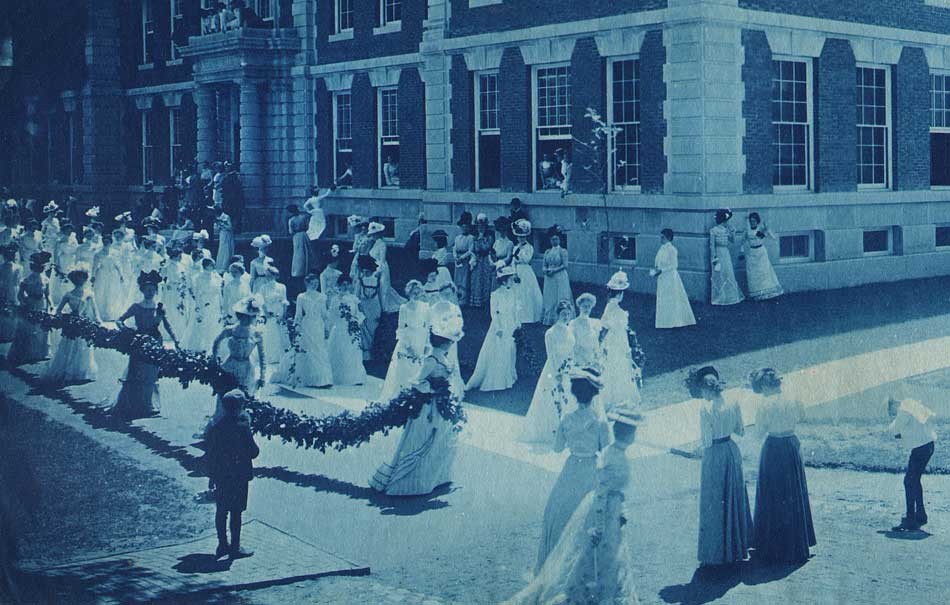 Detail: "Ivy Procession June 18, 1900": vintage cyanotype loosely inserted into dis-bound album leaf: ca. 1900 by unknown American photographer: 10.0 x 24.8 cm | 18.2 x 27.5 cm. Ivy Day at Smith College in Northampton, Massachusetts, the day before Commencement, begins with a procession of graduating seniors walking around Seelye Hall on campus. They are flanked by junior students in foreground carrying the ivy chain, which is actually made of laurel leaves. Notice the two women and young boy at far right of frame photographing the scene with box cameras. Leaf from larger album with direct provenance to Mary Ruth Perkins, 1878-1975; Smith College class of 1900 graduate and Chairman of the class yearbook committee that year. From: PhotoSeed Archive
Detail: "Ivy Procession June 18, 1900": vintage cyanotype loosely inserted into dis-bound album leaf: ca. 1900 by unknown American photographer: 10.0 x 24.8 cm | 18.2 x 27.5 cm. Ivy Day at Smith College in Northampton, Massachusetts, the day before Commencement, begins with a procession of graduating seniors walking around Seelye Hall on campus. They are flanked by junior students in foreground carrying the ivy chain, which is actually made of laurel leaves. Notice the two women and young boy at far right of frame photographing the scene with box cameras. Leaf from larger album with direct provenance to Mary Ruth Perkins, 1878-1975; Smith College class of 1900 graduate and Chairman of the class yearbook committee that year. From: PhotoSeed Archive
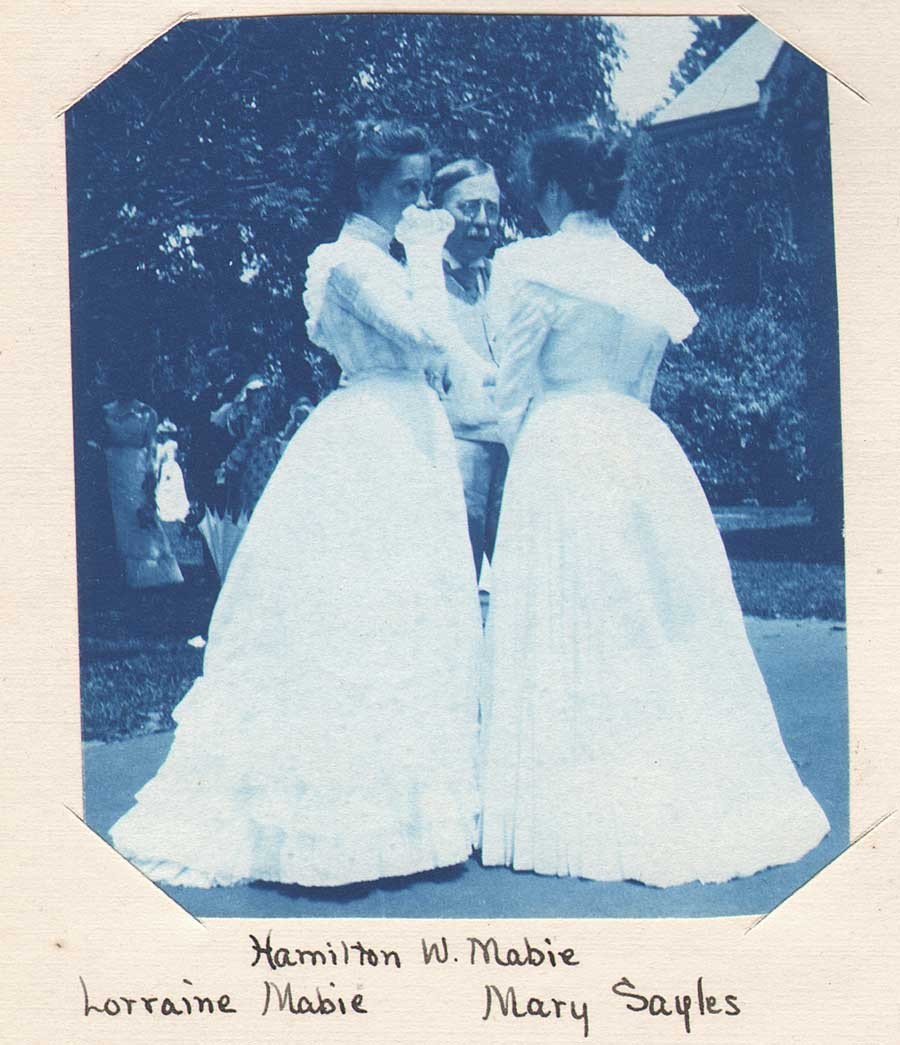 "Hamilton Wright Mabie: Smith College Class of 1900 Commencement Speaker": vintage cyanotype loosely inserted into dis-bound album leaf: ca. 1900 by unknown American photographer: 8.5 x 7.2 cm | 18.2 x 27.5 cm. Mabie, 1846-1916, an American essayist, editor, critic, and lecturer who attended Williams College and Columbia Law School, is shown here in the background along with two Smith graduates: his daughter at left Lorraine Trivett Mabie -1877-1906, and Mary Buell Sayles - 1878-1959, who went on to become a noted social reformer, writer and educator. In 1902, Sayles conducted the first "systemic study of housing conditions in Jersey City" (Davis-1984) and was a New York City housing inspector. Leaf from larger album with direct provenance to Mary Ruth Perkins, 1878-1975; Smith College class of 1900 graduate and Chairman of the class yearbook committee that year. From: PhotoSeed Archive
"Hamilton Wright Mabie: Smith College Class of 1900 Commencement Speaker": vintage cyanotype loosely inserted into dis-bound album leaf: ca. 1900 by unknown American photographer: 8.5 x 7.2 cm | 18.2 x 27.5 cm. Mabie, 1846-1916, an American essayist, editor, critic, and lecturer who attended Williams College and Columbia Law School, is shown here in the background along with two Smith graduates: his daughter at left Lorraine Trivett Mabie -1877-1906, and Mary Buell Sayles - 1878-1959, who went on to become a noted social reformer, writer and educator. In 1902, Sayles conducted the first "systemic study of housing conditions in Jersey City" (Davis-1984) and was a New York City housing inspector. Leaf from larger album with direct provenance to Mary Ruth Perkins, 1878-1975; Smith College class of 1900 graduate and Chairman of the class yearbook committee that year. From: PhotoSeed Archive
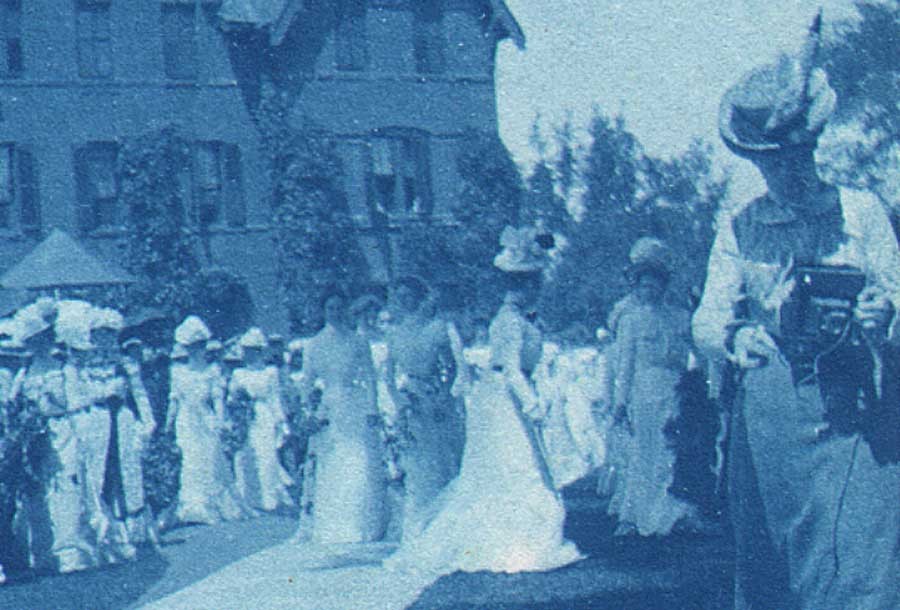 Detail: "Head of Ivy Procession" (June 18, 1900): vintage cyanotype loosely inserted into dis-bound album leaf: ca. 1900 by unknown American photographer: 7.5 x 8.5 cm | 18.2 x 27.5 cm. With the front of the Smith College Ivy Day Procession made up of graduating seniors Cornelia Gould, Carol Weston, Caroline Marmon and Harriette Ross making their way forward in background, a woman with camera at far right of frame walks to position herself for a good vantage point. Leaf from larger album with direct provenance to Mary Ruth Perkins, 1878-1975; Smith College class of 1900 graduate and Chairman of the class yearbook committee that year. From: PhotoSeed Archive
Detail: "Head of Ivy Procession" (June 18, 1900): vintage cyanotype loosely inserted into dis-bound album leaf: ca. 1900 by unknown American photographer: 7.5 x 8.5 cm | 18.2 x 27.5 cm. With the front of the Smith College Ivy Day Procession made up of graduating seniors Cornelia Gould, Carol Weston, Caroline Marmon and Harriette Ross making their way forward in background, a woman with camera at far right of frame walks to position herself for a good vantage point. Leaf from larger album with direct provenance to Mary Ruth Perkins, 1878-1975; Smith College class of 1900 graduate and Chairman of the class yearbook committee that year. From: PhotoSeed Archive
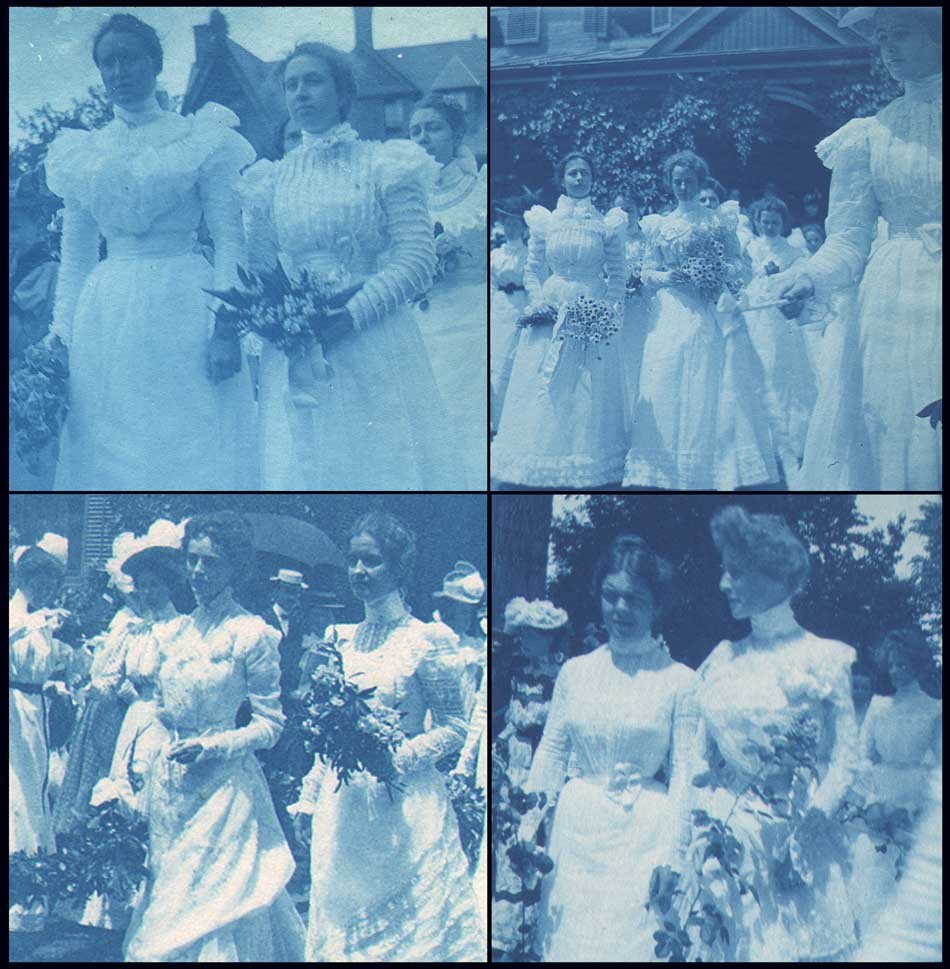 Details: "Head of Ivy Day Procession: 1897-1900" (Smith College, Northampton, Massachusetts). All: vintage cyanotypes loosely inserted into dis-bound album leaves: ca. 1897-1900 by unknown American photographers with each leaf: 18.2 x 27.5 cm. Upper left: 1897: 9.4 x 11.4 cm; Upper right: 1898: 9.5 x 12.0 cm; Lower left: 1899 (Louise & Carrolle Barber) 8.5 x 5.5 cm; Lower right: 1900 (Cornelia Gould, Carol Weston, Caroline Marmon, Harriette Ross) 8.1 x 5.5 cm. Leaves from larger album with direct provenance to Mary Ruth Perkins, 1878-1975; Smith College class of 1900 graduate and Chairman of the class yearbook committee that year. From: PhotoSeed Archive
Details: "Head of Ivy Day Procession: 1897-1900" (Smith College, Northampton, Massachusetts). All: vintage cyanotypes loosely inserted into dis-bound album leaves: ca. 1897-1900 by unknown American photographers with each leaf: 18.2 x 27.5 cm. Upper left: 1897: 9.4 x 11.4 cm; Upper right: 1898: 9.5 x 12.0 cm; Lower left: 1899 (Louise & Carrolle Barber) 8.5 x 5.5 cm; Lower right: 1900 (Cornelia Gould, Carol Weston, Caroline Marmon, Harriette Ross) 8.1 x 5.5 cm. Leaves from larger album with direct provenance to Mary Ruth Perkins, 1878-1975; Smith College class of 1900 graduate and Chairman of the class yearbook committee that year. From: PhotoSeed Archive
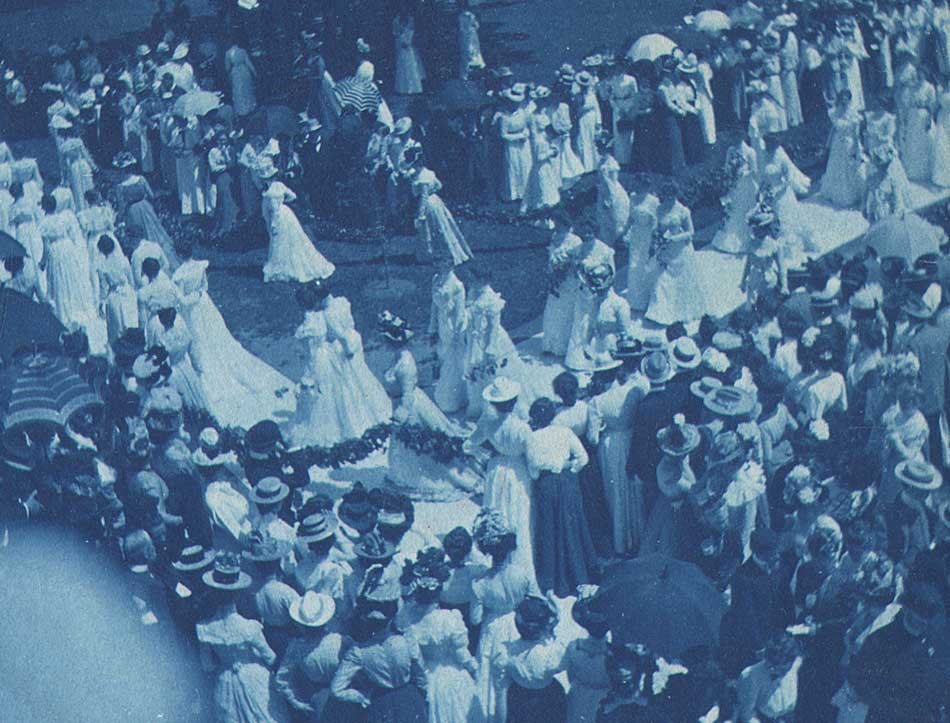 Detail: "Ivy Procession on the way from College Hall around Seelye Hall" (June 18, 1900): vintage cyanotype loosely inserted into dis-bound album leaf: ca. 1900 by unknown American photographer: 8.3 x 8.5 cm | 18.2 x 27.5 cm.Taken from an overhead angle, this photograph shows throngs of hat wearing spectators in foreground and background watching the procession of graduating Smith College seniors. Each wearing their traditional long white dresses, they walk in pairs while flanked by junior class members holding the ivy chain made from laurel leaves. Leaf from larger album with direct provenance to Mary Ruth Perkins, 1878-1975; Smith College class of 1900 graduate and Chairman of the class yearbook committee that year. From: PhotoSeed Archive
Detail: "Ivy Procession on the way from College Hall around Seelye Hall" (June 18, 1900): vintage cyanotype loosely inserted into dis-bound album leaf: ca. 1900 by unknown American photographer: 8.3 x 8.5 cm | 18.2 x 27.5 cm.Taken from an overhead angle, this photograph shows throngs of hat wearing spectators in foreground and background watching the procession of graduating Smith College seniors. Each wearing their traditional long white dresses, they walk in pairs while flanked by junior class members holding the ivy chain made from laurel leaves. Leaf from larger album with direct provenance to Mary Ruth Perkins, 1878-1975; Smith College class of 1900 graduate and Chairman of the class yearbook committee that year. From: PhotoSeed Archive
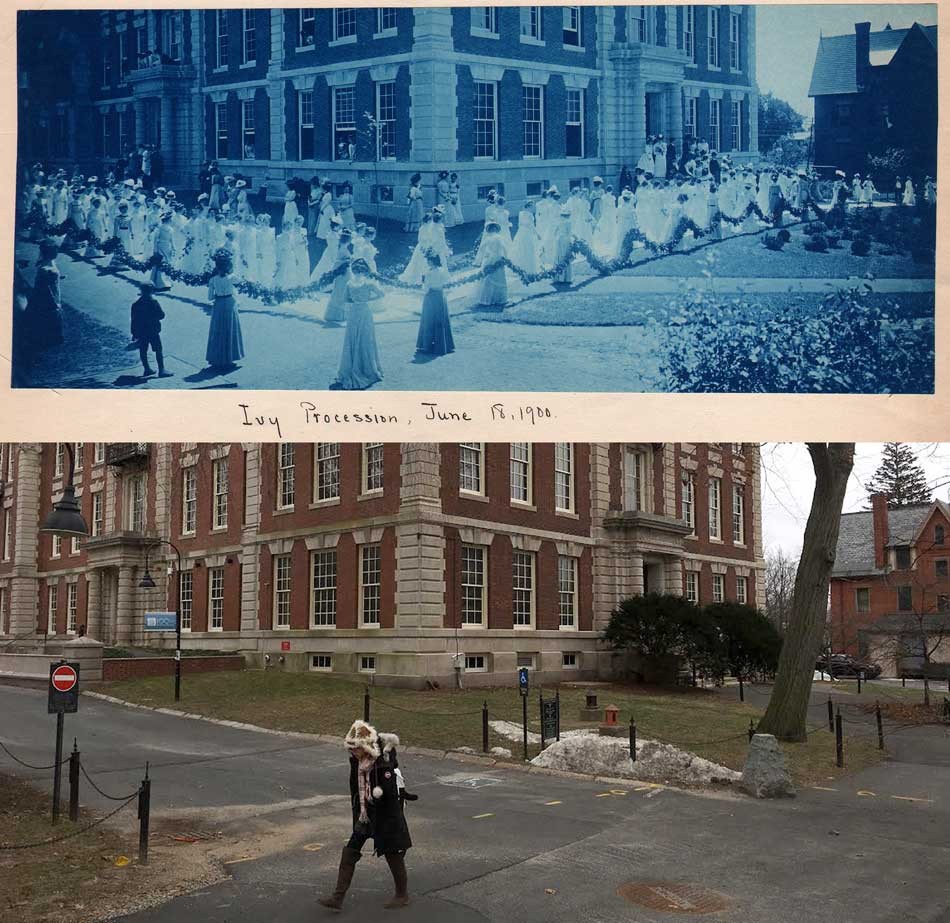 Top: "Ivy Procession June 18, 1900": vintage cyanotype loosely inserted into dis-bound album leaf: ca. 1900 by unknown American photographer: 10.1 x 24.5 cm | 18.2 x 27.5 cm. Ivy Day at Smith College in Northampton, Massachusetts, the day before Commencement, begins with a procession of graduating seniors walking around Seelye Hall on campus. They are flanked by junior students in foreground carrying the ivy chain, which is actually made of laurel leaves. From the college website: "Ivy Day has been a Smith tradition for more than a century. The class of 1884 was the first to plant ivy as part of the ceremonies leading to its graduation, thus providing the day with its name." Leaf from larger album with direct provenance to Mary Ruth Perkins, 1878-1975; Smith College class of 1900 graduate and Chairman of the class yearbook committee that year. From: PhotoSeed Archive. Bottom: "Seelye Hall, Smith College Campus". From the same vantage point as the panoramic photograph taken above, this digital iPhone photograph from January 15, 2018 shows what the campus looks like today. Named after the first president of the college L. Clark Seelye, construction on Seelye began in 1898 and it opened the following year. Photo by David Spencer for PhotoSeed Archive.
Top: "Ivy Procession June 18, 1900": vintage cyanotype loosely inserted into dis-bound album leaf: ca. 1900 by unknown American photographer: 10.1 x 24.5 cm | 18.2 x 27.5 cm. Ivy Day at Smith College in Northampton, Massachusetts, the day before Commencement, begins with a procession of graduating seniors walking around Seelye Hall on campus. They are flanked by junior students in foreground carrying the ivy chain, which is actually made of laurel leaves. From the college website: "Ivy Day has been a Smith tradition for more than a century. The class of 1884 was the first to plant ivy as part of the ceremonies leading to its graduation, thus providing the day with its name." Leaf from larger album with direct provenance to Mary Ruth Perkins, 1878-1975; Smith College class of 1900 graduate and Chairman of the class yearbook committee that year. From: PhotoSeed Archive. Bottom: "Seelye Hall, Smith College Campus". From the same vantage point as the panoramic photograph taken above, this digital iPhone photograph from January 15, 2018 shows what the campus looks like today. Named after the first president of the college L. Clark Seelye, construction on Seelye began in 1898 and it opened the following year. Photo by David Spencer for PhotoSeed Archive.
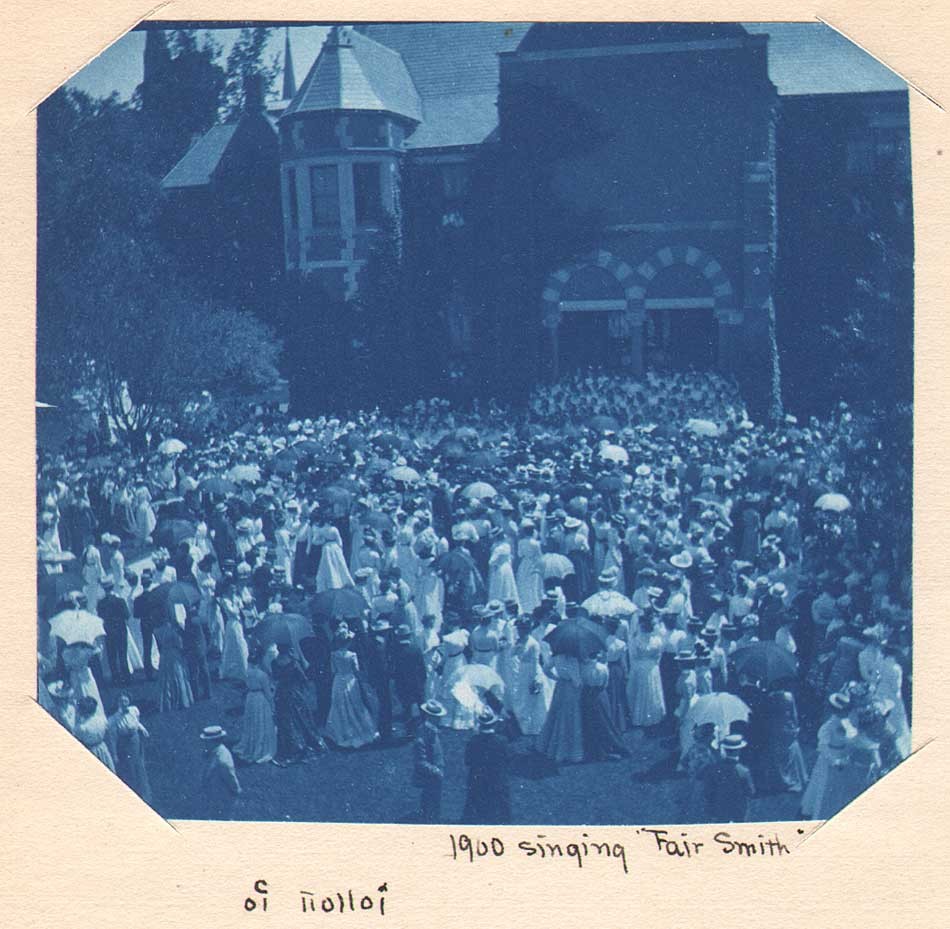 "Singing Fair Smith": vintage cyanotype loosely inserted into dis-bound album leaf: ca. 1900 by unknown American photographer: 7.7 x 8.5 cm | 18.2 x 27.5 cm. On Ivy Day at Smith College in Northampton, Massachusetts, hundreds gather in front of College Hall to watch members of the choir assembled on the steps sing the traditional 1890 song "Fair Smith". The lyrics are by R.K. Crandall and Dr. B.C. Blodgett: "Fair Smith, our praise to thee we render, O dearest college halls, Bright hours that live in mem'ry tender, Are wing'd within thy walls. O'er thy walks the elms are bowing, Alma Mater, Winds 'mid branches softly blowing, Ivy round thy tower growing, Alma Mater. "And while the hills with purple shadows Eternal vigil keep Above the happy river meadows, In golden haze asleep. May thy children still addressing, Alma Mater. Thee with grateful praise addressing, Speak in loyal hearts thy blessing, Alma Mater." Leaf from larger album with direct provenance to Mary Ruth Perkins, 1878-1975; Smith College class of 1900 graduate and Chairman of the class yearbook committee that year. From: PhotoSeed Archive
"Singing Fair Smith": vintage cyanotype loosely inserted into dis-bound album leaf: ca. 1900 by unknown American photographer: 7.7 x 8.5 cm | 18.2 x 27.5 cm. On Ivy Day at Smith College in Northampton, Massachusetts, hundreds gather in front of College Hall to watch members of the choir assembled on the steps sing the traditional 1890 song "Fair Smith". The lyrics are by R.K. Crandall and Dr. B.C. Blodgett: "Fair Smith, our praise to thee we render, O dearest college halls, Bright hours that live in mem'ry tender, Are wing'd within thy walls. O'er thy walks the elms are bowing, Alma Mater, Winds 'mid branches softly blowing, Ivy round thy tower growing, Alma Mater. "And while the hills with purple shadows Eternal vigil keep Above the happy river meadows, In golden haze asleep. May thy children still addressing, Alma Mater. Thee with grateful praise addressing, Speak in loyal hearts thy blessing, Alma Mater." Leaf from larger album with direct provenance to Mary Ruth Perkins, 1878-1975; Smith College class of 1900 graduate and Chairman of the class yearbook committee that year. From: PhotoSeed Archive
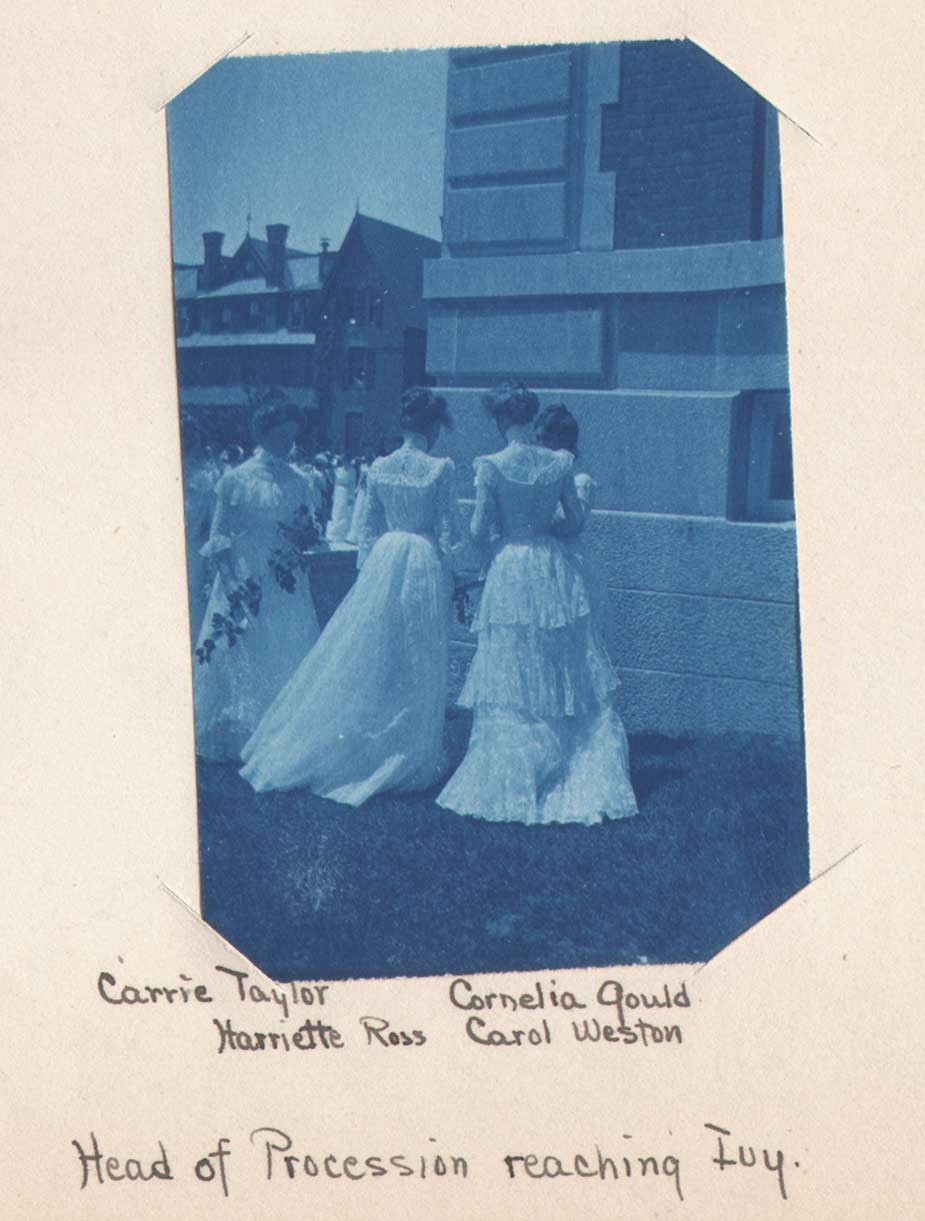 "Head of Procession reaching Ivy": vintage cyanotype loosely inserted into dis-bound album leaf: ca. 1900 by unknown American photographer: 8.3 x 5.4 cm | 18.2 x 27.5 cm. Smith College graduating seniors who headed up the Ivy Day Procession on June 18, 1900-Cornelia Gould, Carol Weston, Caroline Marmon and Harriette Ross, stand at the base of Seelye Hall where they prepare to plant ivy plant seedlings. Leaf from larger album with direct provenance to Mary Ruth Perkins, 1878-1975; Smith College class of 1900 graduate and Chairman of the class yearbook committee that year. From: PhotoSeed Archive
"Head of Procession reaching Ivy": vintage cyanotype loosely inserted into dis-bound album leaf: ca. 1900 by unknown American photographer: 8.3 x 5.4 cm | 18.2 x 27.5 cm. Smith College graduating seniors who headed up the Ivy Day Procession on June 18, 1900-Cornelia Gould, Carol Weston, Caroline Marmon and Harriette Ross, stand at the base of Seelye Hall where they prepare to plant ivy plant seedlings. Leaf from larger album with direct provenance to Mary Ruth Perkins, 1878-1975; Smith College class of 1900 graduate and Chairman of the class yearbook committee that year. From: PhotoSeed Archive
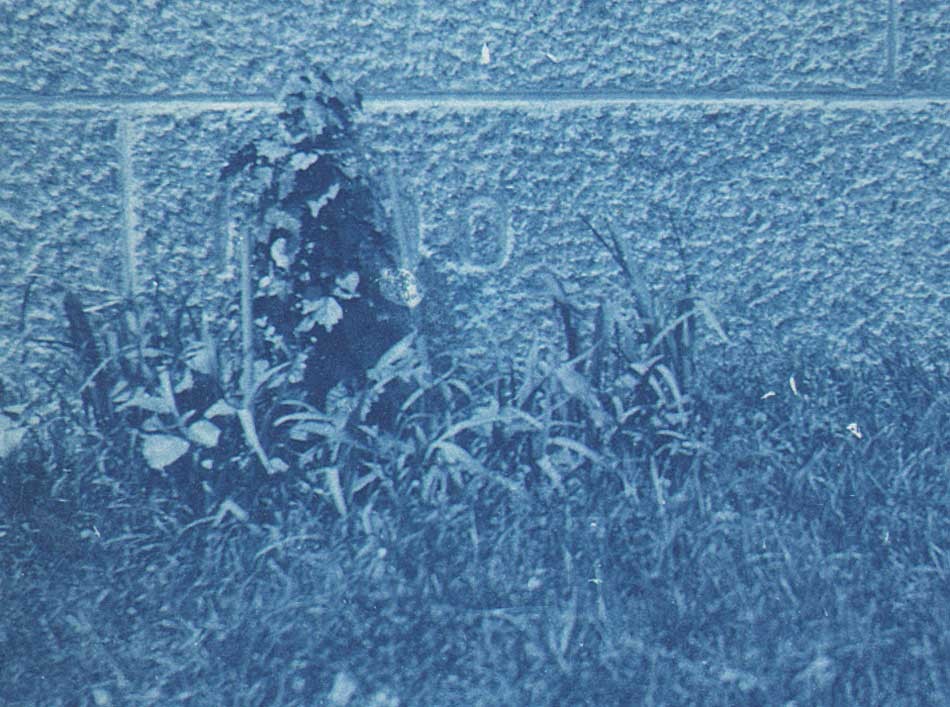 Detail: "Ivy vine seedling at base of Seelye Hall": vintage cyanotype loosely inserted into dis-bound album leaf: ca. 1900 by unknown American photographer: 8.3 x 8.0 cm | 18.2 x 27.5 cm. The evidence of Ivy Day at Smith College on June 18, 1900 is this Ivy seedling, planted against the year "1900" chiseled into the base of the then brand new Seelye Hall, a rusticated Georgian Revival building on campus designed by the New York firm of York and Sawyer. Construction on this surviving academic building which first housed classrooms and a library began in 1898 and was completed in 1899. The building took its name from L. Clark Seelye, (1837-1924) the first president of Smith College who served from 1875-1910. Rockefeller Hall at Vassar, an 1897 commission by the same firm, was the model for Seelye. Leaf from larger album with direct provenance to Mary Ruth Perkins, 1878-1975; Smith College class of 1900 graduate and Chairman of the class yearbook committee that year. From: PhotoSeed Archive
Detail: "Ivy vine seedling at base of Seelye Hall": vintage cyanotype loosely inserted into dis-bound album leaf: ca. 1900 by unknown American photographer: 8.3 x 8.0 cm | 18.2 x 27.5 cm. The evidence of Ivy Day at Smith College on June 18, 1900 is this Ivy seedling, planted against the year "1900" chiseled into the base of the then brand new Seelye Hall, a rusticated Georgian Revival building on campus designed by the New York firm of York and Sawyer. Construction on this surviving academic building which first housed classrooms and a library began in 1898 and was completed in 1899. The building took its name from L. Clark Seelye, (1837-1924) the first president of Smith College who served from 1875-1910. Rockefeller Hall at Vassar, an 1897 commission by the same firm, was the model for Seelye. Leaf from larger album with direct provenance to Mary Ruth Perkins, 1878-1975; Smith College class of 1900 graduate and Chairman of the class yearbook committee that year. From: PhotoSeed Archive
In 1900, when these cyanotype photographs were taken, a new century beckoned on Ivy Day for those who would soon graduate from Smith. Like then as in the present, newly minted graduates the world over feel the same emotions that strains of Pomp and Circumstance invoke and traditions call for. Laurels are bestowed for hard work, fortunes and insight will be made or come from it, and hopefully, friendships made during college days will endure far into the future.
Sugaring
Posted March 2018 in Documentary Photography, Significant Photographers
“Of all that long season of snow, I remember most pleasantly the days that were sweetened with the sugar-making. When the sun was lifting his course in the clearing sky, and March had got the temper of the lamb, and the frozen pulses of the forest had begun to stir, the great kettle was mounted in the yard and all gave a hand to the washing of spouts and buckets.
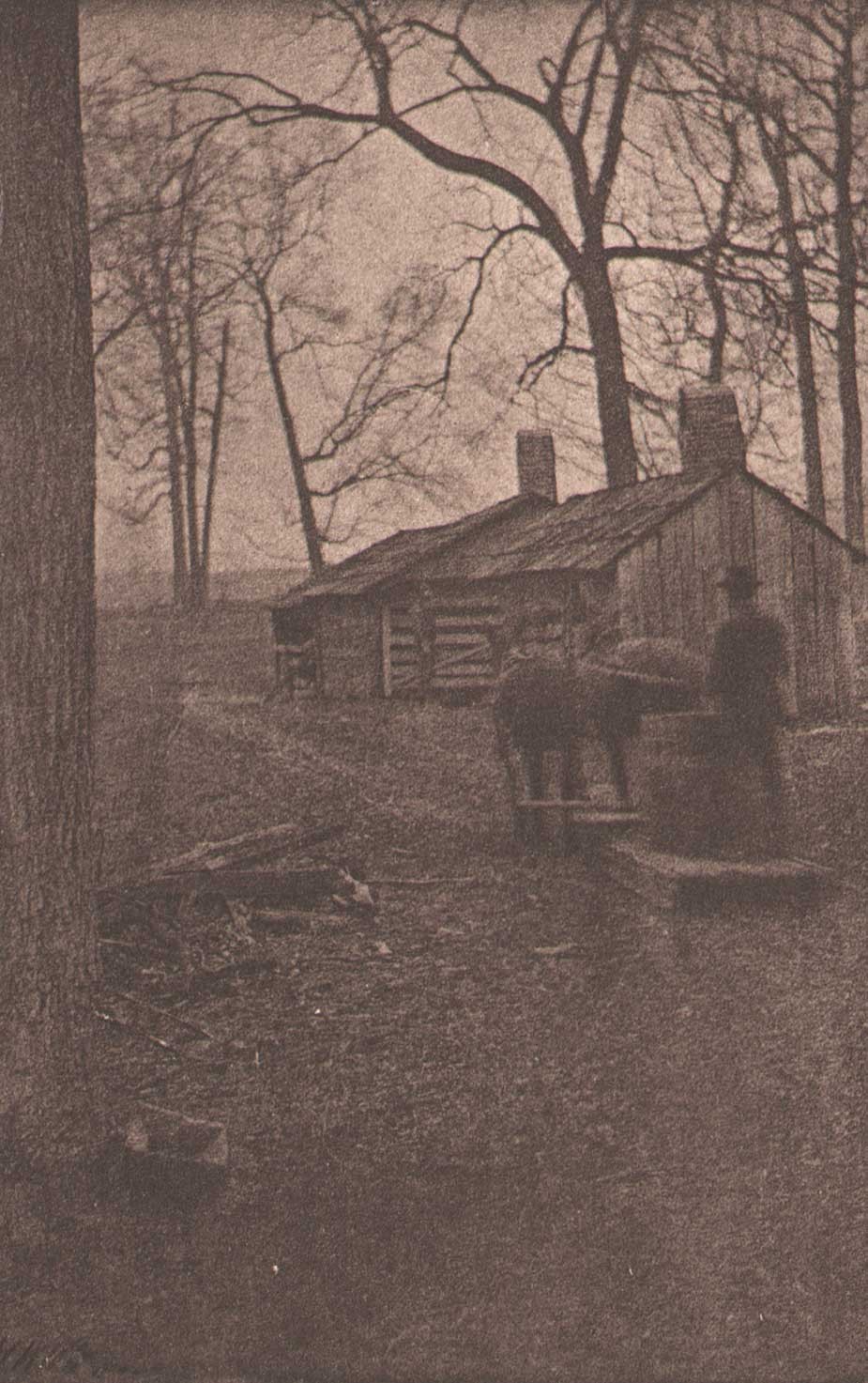 "The Sugar Camp": Clarence H. White, American: 1903: vintage hand-pulled photogravure. 12.2 x 7.7 | 20.0 x 13.9 cm. A team of horses pulls a wooden sled guided by a sugar camp worker and carrying a barrel of tree sap to a sugar shack in the distance. The gravure was included in a special edition of the best selling novel Eben Holden written by Irving Bacheller. PhotoSeed Archive
"The Sugar Camp": Clarence H. White, American: 1903: vintage hand-pulled photogravure. 12.2 x 7.7 | 20.0 x 13.9 cm. A team of horses pulls a wooden sled guided by a sugar camp worker and carrying a barrel of tree sap to a sugar shack in the distance. The gravure was included in a special edition of the best selling novel Eben Holden written by Irving Bacheller. PhotoSeed Archive
Then came tapping time, in which I helped carry the buckets and tasted the sweet flow that followed the auger’s wound. The woods were merry with our shouts, and, shortly, one could hear the heart-beat of the maples in the sounding bucket. It was the reveille of spring. Towering trees shook down the gathered storms of snow and felt for the sunlight. The arch and shanty were repaired, the great iron kettle was scoured and lifted to its place, and then came the boiling. It was a great, an inestimable privilege to sit on the robes of faded fur, in the shanty, and hear the fire roaring under the kettle and smell the sweet odor of the boiling sap.” - Irving Bacheller, from Eben Holden (1.)
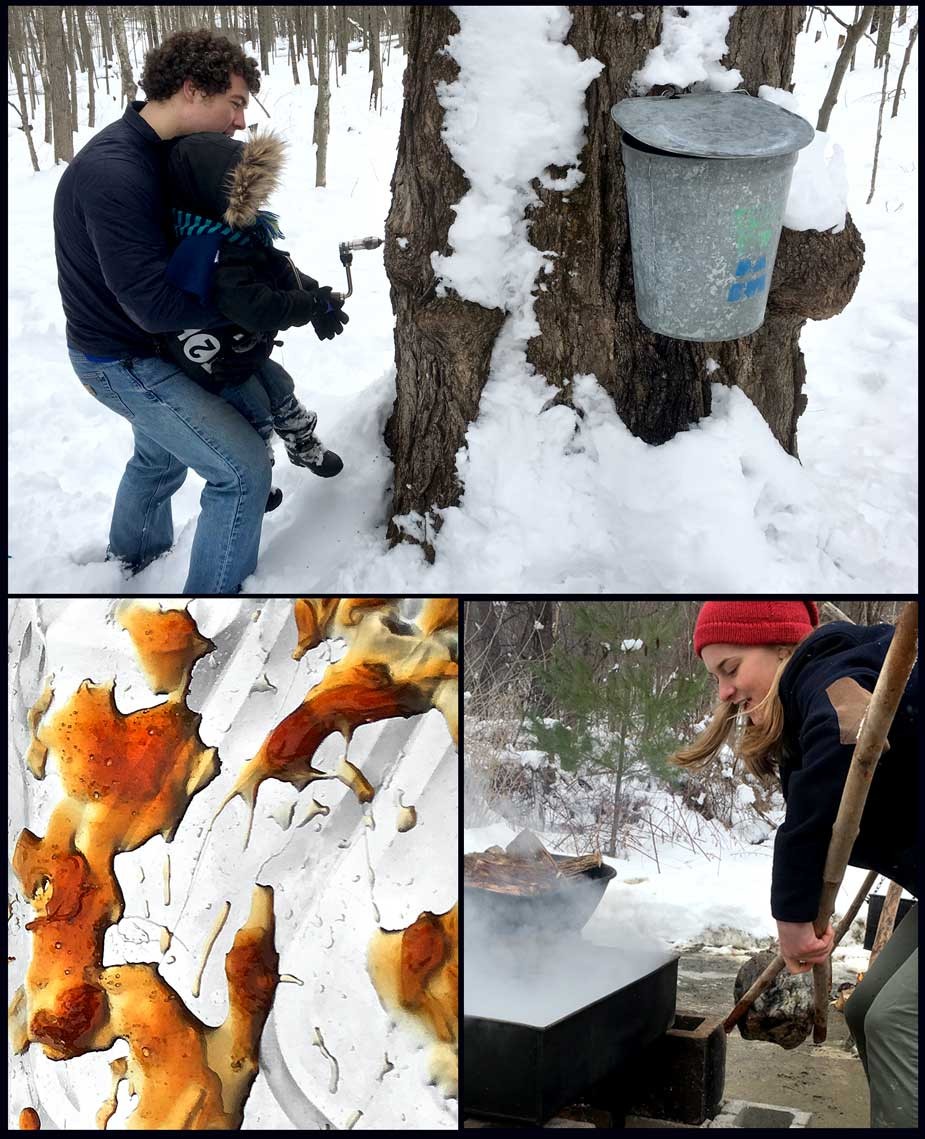 An annual harbinger of Spring, Maple Fest was held on the grounds of the 2600-acre Hopkins Memorial Forest located in Williamstown, MA on Saturday, March 10, 2018. The educational and fun event gave visitors the opportunity to experience the collection of maple sap, to its' being boiled down in a sugar shack to make maple syrup and the experience of tasting it as pure candy solidified after being drizzled onto fresh snow. Top: a young visitor holding a drill is guided by a Williams College student in tapping a sugar maple tree. An old-fashioned metal bucket at right is still used, with 40-50 gallons of sap collected and boiled down to make one gallon of syrup. Left: Amber, crystalline maple syrup is left behind on the bottom of a foil sheet that once held packed snow. Right: Historic evaporation methods to boil down maple sap were demonstrated, with another Williams student carefully maneuvering a hot rock taken from coals that would be transferred to a hollowed-out log- the method Native Americans first used to turn sap into syrup. All: David Spencer for PhotoSeed Archive
An annual harbinger of Spring, Maple Fest was held on the grounds of the 2600-acre Hopkins Memorial Forest located in Williamstown, MA on Saturday, March 10, 2018. The educational and fun event gave visitors the opportunity to experience the collection of maple sap, to its' being boiled down in a sugar shack to make maple syrup and the experience of tasting it as pure candy solidified after being drizzled onto fresh snow. Top: a young visitor holding a drill is guided by a Williams College student in tapping a sugar maple tree. An old-fashioned metal bucket at right is still used, with 40-50 gallons of sap collected and boiled down to make one gallon of syrup. Left: Amber, crystalline maple syrup is left behind on the bottom of a foil sheet that once held packed snow. Right: Historic evaporation methods to boil down maple sap were demonstrated, with another Williams student carefully maneuvering a hot rock taken from coals that would be transferred to a hollowed-out log- the method Native Americans first used to turn sap into syrup. All: David Spencer for PhotoSeed Archive
1. Eben Holden: Chapter VIII: Boston, Lothrop Publishing Company: 1903: p. 95
The Beautiful Beyond
Posted September 2017 in Childhood Photography, Documentary Photography, PhotoSeed
PhotoSeed celebrates the life of one of its profound influences on the recent passing of my father Charles Edward Spencer 1925-2017.
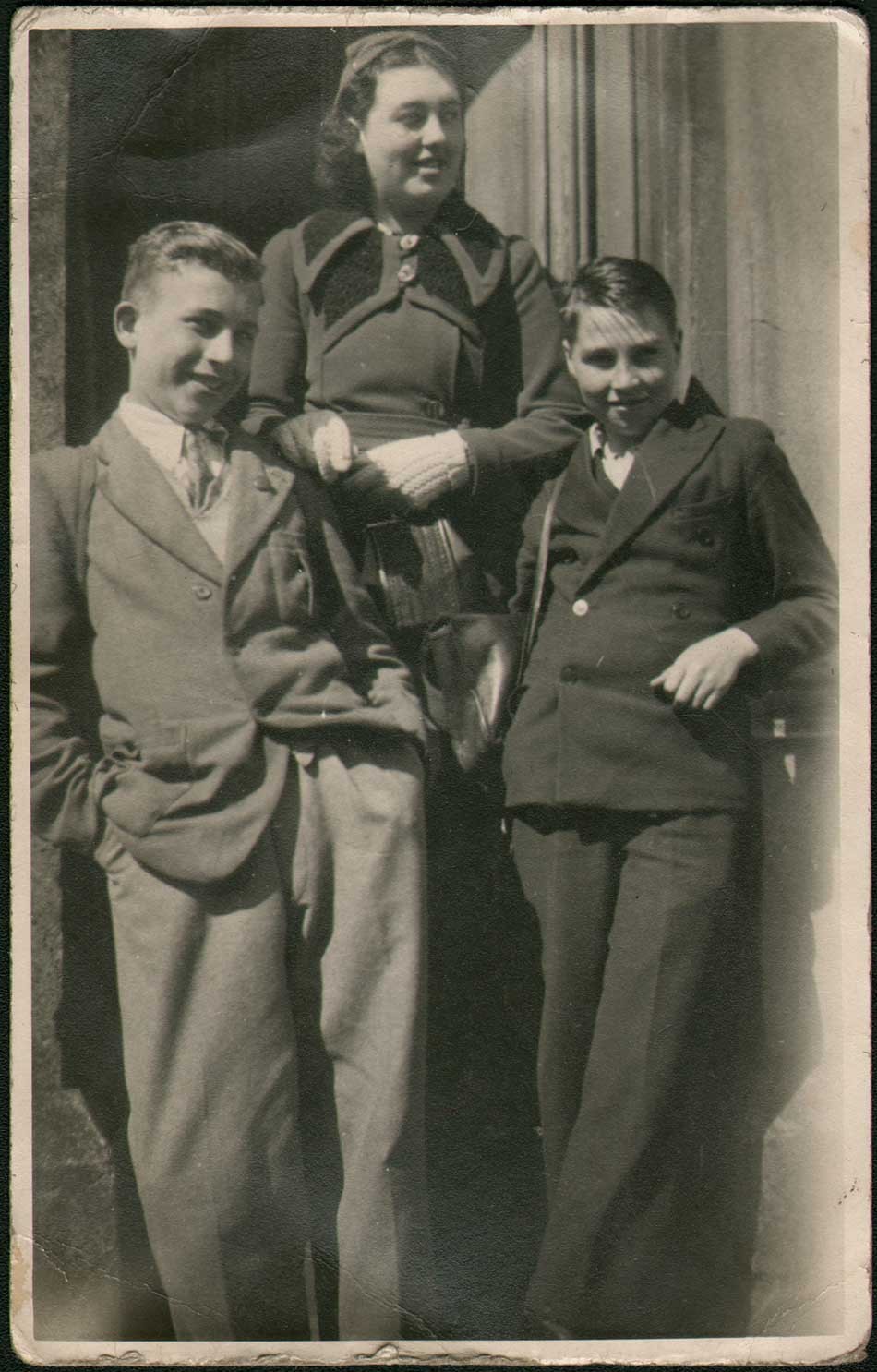 "Charlie Spencer and WWII Classmates" : unknown English photographer: gelatin silver K(odak) Ltd postcard ca. 1940: 13.8 x 8.7 cm : The author's father, about 15, is seen at far left striking a pose in Workington, on the west coast of Cumbria England (Cumberland county) during the early part of World War II. Born in Holyoke, Massachusetts in 1925 to English parents who sought their fortune in the United States, the American Depression forced the family back to their native Newcastle upon Tyne by 1933. A favored German aerial target during the war because of its important shipbuilding industry, Charlie was evacuated along with over 800,000 English school age children from Newcastle and other large English cities beginning in late 1939 as part of the British government's Operation Pied Piper, which eventually displaced 3.5 million people in the UK. Late in the war, he returned to Newcastle, (Benwell) reuniting with his parents Charles and Jane (Garland) Spencer and graduating there from Atkinson Road Technical School. An American by birth, he soon found himself serving in the U.S. Army of Occupation in Germany, where he was a reporter for the Stars and Stripes newspaper among other duties. His first eight years in America had certainly made an impression however, and he returned to the states for good in early 1949 aboard the troop ship USNS General Maurice Rose. Settling in the greater Bridgeport, CT area, he went on to become an advertising and sales promotion specialist for the General Electric Company in their small appliance division for fifteen years and later in the same capacity with other business ventures in CT. Married 61 years to Ann, he passed away in September, 2017. Note: girl in photograph is daughter from Workington family with whom Charlie stayed with during his billet. After Workington, he was billeted with another family in Siddick England. From: Authors personal family archive.
"Charlie Spencer and WWII Classmates" : unknown English photographer: gelatin silver K(odak) Ltd postcard ca. 1940: 13.8 x 8.7 cm : The author's father, about 15, is seen at far left striking a pose in Workington, on the west coast of Cumbria England (Cumberland county) during the early part of World War II. Born in Holyoke, Massachusetts in 1925 to English parents who sought their fortune in the United States, the American Depression forced the family back to their native Newcastle upon Tyne by 1933. A favored German aerial target during the war because of its important shipbuilding industry, Charlie was evacuated along with over 800,000 English school age children from Newcastle and other large English cities beginning in late 1939 as part of the British government's Operation Pied Piper, which eventually displaced 3.5 million people in the UK. Late in the war, he returned to Newcastle, (Benwell) reuniting with his parents Charles and Jane (Garland) Spencer and graduating there from Atkinson Road Technical School. An American by birth, he soon found himself serving in the U.S. Army of Occupation in Germany, where he was a reporter for the Stars and Stripes newspaper among other duties. His first eight years in America had certainly made an impression however, and he returned to the states for good in early 1949 aboard the troop ship USNS General Maurice Rose. Settling in the greater Bridgeport, CT area, he went on to become an advertising and sales promotion specialist for the General Electric Company in their small appliance division for fifteen years and later in the same capacity with other business ventures in CT. Married 61 years to Ann, he passed away in September, 2017. Note: girl in photograph is daughter from Workington family with whom Charlie stayed with during his billet. After Workington, he was billeted with another family in Siddick England. From: Authors personal family archive.
The call would come, I had convinced myself, for years. But it waited patiently. I reassured myself I was prepared, but for naught. When it did, from my brother Will, it was from his childhood voice over 50 years gone: punctuating his cries through the distance, he gasped for breath: “Dad did not wake up” he somehow forced through his cracking voice, cries and tears. My own response immediate: a shuddering to my core equal to his-helpless feelings not revisited since my toddler days-cries my father was now unable to comfort as he did throughout my entire life ⎯the finality of it all.
But goodness had shined its light, in this most profound form of sudden loss: my dad was now truly free of any miseries real for him in the physical present, and ones our family perceived in him during his long and noticeable decline. Vanquished. He was now free, and on his journey to the beautiful beyond.
David Spencer-
Freedom of Jones
Posted July 2017 in Documentary Photography, History of Photography, Unknown Photographers
That experiment of American Democracy, culminating in our annual celebration today of the Fourth of July holiday, has survived 241 times since that fateful Philadelphia signing, in 1776, of a remarkable document giving notice to the larger world our Declaration of Independence and legal right to self-rule, with benefits.
 Detail: "Asbury Park Boardwalk": Laural J. Jones, American: 2004 digital scan taken from ca. 1938-1945 black and white film negative: A woman who may have become the photographer's second wife, Edith, sits with a white hat on her lap on a bench at center in this bustling summer boardwalk scene taken at the Fourth Ave. entrance. The 18-hole Asbury Park Obstacle Golf course can be seen directly behind the bench at center and at left. Courtesy: Private Florida Collection
Detail: "Asbury Park Boardwalk": Laural J. Jones, American: 2004 digital scan taken from ca. 1938-1945 black and white film negative: A woman who may have become the photographer's second wife, Edith, sits with a white hat on her lap on a bench at center in this bustling summer boardwalk scene taken at the Fourth Ave. entrance. The 18-hole Asbury Park Obstacle Golf course can be seen directly behind the bench at center and at left. Courtesy: Private Florida Collection
Freedom of expression, and with it speech as it relates to the right of picking up a camera and chronicling daily life in one own’s creative bent without fear or favor are American freedoms held dearly by this website. I long hope our presently divided country can see the worth and value of all her citizens understanding each other and getting along for the betterment of the whole.
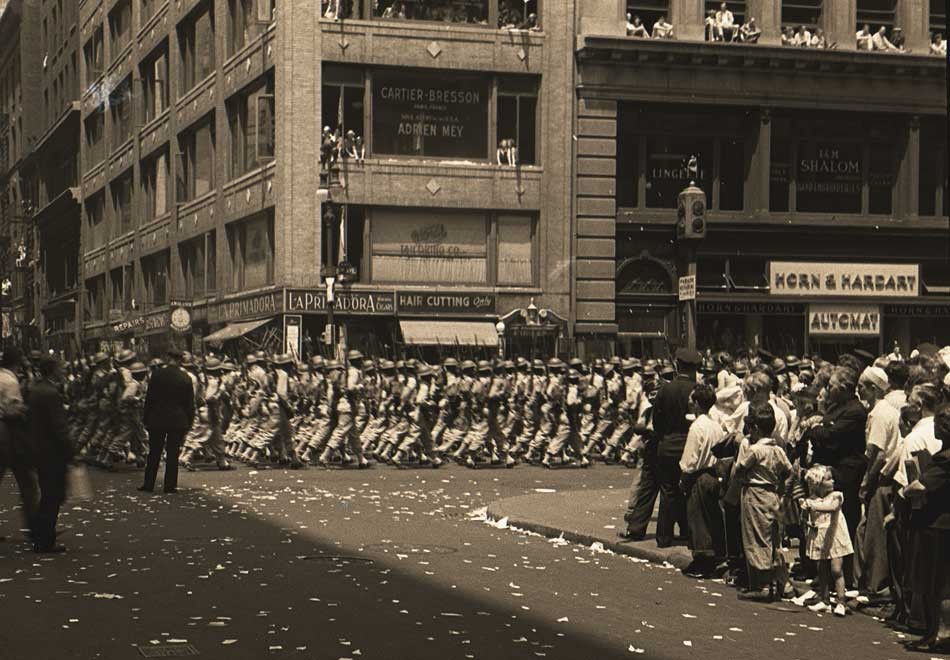 Detail: "Fifth Avenue Military Parade": Laural J. Jones, American: 2004 digital scan taken from ca. 1938-1945 black and white film negative: Possibly taken before World War II, a little girl at far right holds an American flag as US infantry troops march up Fifth Ave. in New York City. The location of the photograph is W. 27th Street. The former La Primadora Havana Cigar shop can be seen at center at 234 Fifth Ave. and a Horn & Hardart automat is in the lower floor retail area next door at 236 Fifth Ave. Courtesy: Private Florida Collection
Detail: "Fifth Avenue Military Parade": Laural J. Jones, American: 2004 digital scan taken from ca. 1938-1945 black and white film negative: Possibly taken before World War II, a little girl at far right holds an American flag as US infantry troops march up Fifth Ave. in New York City. The location of the photograph is W. 27th Street. The former La Primadora Havana Cigar shop can be seen at center at 234 Fifth Ave. and a Horn & Hardart automat is in the lower floor retail area next door at 236 Fifth Ave. Courtesy: Private Florida Collection
Not Lost Forever: the work of Laural J. Jones
With the blessing of a good friend who owns this documentary work in the form of developed 35mm black & white film negatives, and dating more than 20 years past the offerings of the more typical pictorialist body of work featured on PhotoSeed, I’m taking advantage of America’s national holiday to introduce to the world a gentleman who knew a thing or two about self-expressionistic ideals enshrined in our Constitution, the work of American amateur photographer Laural J.(ohn) Jones. (1897-1980)
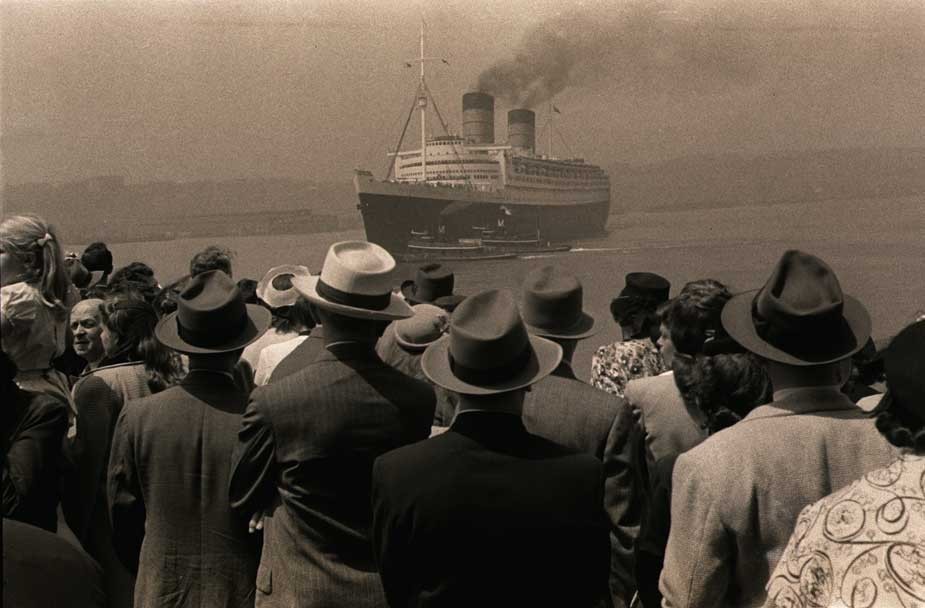 Detail: "RMS Queen Elizabeth in New York Harbor": Laural J. Jones, American: 2004 digital scan taken from ca. 1940-1945 black and white film negative: Although it is unknown when this photograph was taken, onlookers witness the famed 85,000 ton RMS Queen Elizabeth ocean liner in this photo. She initially docked on March 7, 1940 at Pier 90 in quarantine anchorage off Staten Island following a secret voyage to the US from Greenock, Scotland in order to evade German bombers. Courtesy: Private Florida Collection
Detail: "RMS Queen Elizabeth in New York Harbor": Laural J. Jones, American: 2004 digital scan taken from ca. 1940-1945 black and white film negative: Although it is unknown when this photograph was taken, onlookers witness the famed 85,000 ton RMS Queen Elizabeth ocean liner in this photo. She initially docked on March 7, 1940 at Pier 90 in quarantine anchorage off Staten Island following a secret voyage to the US from Greenock, Scotland in order to evade German bombers. Courtesy: Private Florida Collection
Reminiscent in some ways to the much larger body of unknown photographs done by Chicago nanny Vivian Maier (1926-2009) after her life’s work was rescued from a storage locker in 2007, Jones work by contrast and fate was preserved in only two shoe boxes. Residing for more than five years in a Florida antique store before being discovered and saved, spooled negatives by Laural Jones along with an assortment of very small printed photographs are believed to have been placed there from an estate sale originating from the photographer’s second wife Edith, who had lived with Laural in the community of Harbour Oaks, south of Daytona Beach.
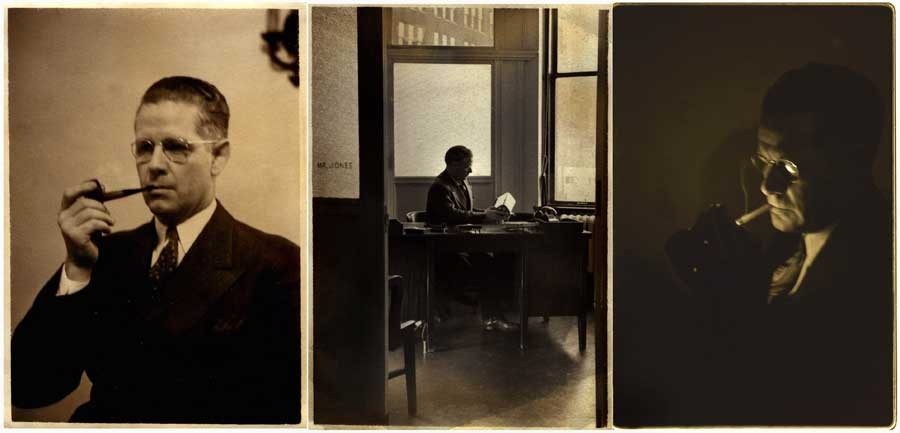 "Self-Portraits of Laural J. Jones: 1897-1980": Laural J. Jones, American: 2004 digital scans taken from ca. 1938-1953: black and white film negatives: The photographer is seen here in a series of self portraits with the center view taken at his office in New York City, where he was employed as the secretary of purchasing for Bell Bakeries, Inc. Courtesy: Private Florida Collection
"Self-Portraits of Laural J. Jones: 1897-1980": Laural J. Jones, American: 2004 digital scans taken from ca. 1938-1953: black and white film negatives: The photographer is seen here in a series of self portraits with the center view taken at his office in New York City, where he was employed as the secretary of purchasing for Bell Bakeries, Inc. Courtesy: Private Florida Collection
Since all that remains are negatives, and with sparse details of his life slowly emerging from US Census and other web resources and records only recently, the Michigan-born Jones is known to have owned the then-new Leica camera sometime around 1938, around the time he is believed to have commenced his early interest in photography. In one surviving photograph stamped 1942 that is an obvious self-portrait, the photographer is nattily dressed and smoking a pipe while he inspects a copy of Popular Photography magazine.
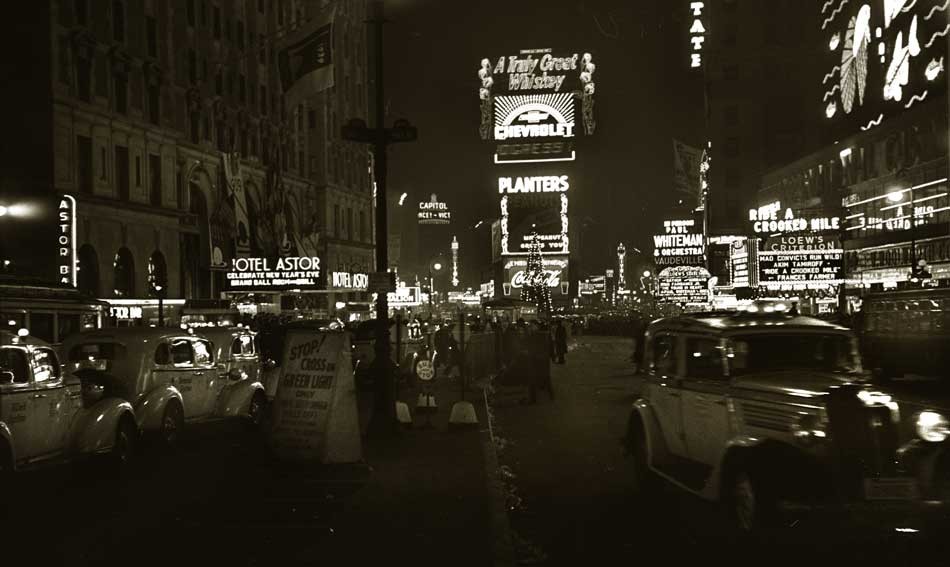 Detail: "1938: Times Square at Night": Laural J. Jones, American: 2004 digital scans taken from ca. 1938 black and white film negative: In this view showing Times Square at night in New York City taken between Christmas and New Year's Eve 1938, a large banner for the year 1939 hangs above the entrance to the Hotel Astor at far left which exclaims those to Celebrate New year's Eve in their Grand Ball Room and Grill. A large lighted Christmas tree is in center background while at far right, the Loew's Criterion marquee advertises in glowing lights the American movie western "Ride a Crooked Mile" starring Akim Tamiroff and Frances Farmer. Courtesy: Private Florida Collection
Detail: "1938: Times Square at Night": Laural J. Jones, American: 2004 digital scans taken from ca. 1938 black and white film negative: In this view showing Times Square at night in New York City taken between Christmas and New Year's Eve 1938, a large banner for the year 1939 hangs above the entrance to the Hotel Astor at far left which exclaims those to Celebrate New year's Eve in their Grand Ball Room and Grill. A large lighted Christmas tree is in center background while at far right, the Loew's Criterion marquee advertises in glowing lights the American movie western "Ride a Crooked Mile" starring Akim Tamiroff and Frances Farmer. Courtesy: Private Florida Collection
Earlier, on Thanksgiving day in 1918, he was first married to the former Ruby A. Armour, (1899-1977) and is listed in a newspaper wedding announcement from the time as being the assistant manager of the Grand Leader Department Store in Battle Creek, with Ruby working there as a clerk. The year of the marriage, the future photographer is described as tall and slender with blue eyes on his World War I draft card, although it appears he was never called up. The couple lived with Laural’s father Mayver Jones, a carpenter for the Advance-Rumely Co., and mother Cora at their home at 129 Somerset Ave. in Battle Creek.
An interesting newspaper account from 1933 showed Laural shared a passion for carpentry like his father, and was also skilled in design. That year he spent several months constructing and designing a custom travel trailer coach in his father’s Someset Ave. carpentry shop meant to “conform with the new stream-line automobiles”. It was: “20 feet in length, maroon color with aluminum top. The interior is divided into two compartments, and is finished throughout in paneled veneer, walnut finish. The forward compartment is furnished with built-in library table, Pullman couch upholstered in brown Spanish leather with chairs to match, and folding typewriter desk, and radio, with an oval rug as floor covering.” The couple also seemed to have the luxery of time and money: they hit the road late that Fall pulling the new coach in route to St. Petersburg, FL, where they spent the Winter.
In 1935, according to his 1980 obituary, Laural moved to New York City from Michigan in order to serve as secretary in charge of purchasing for Bell Bakeries Inc., a large commercial concern with factories throughout the eastern seaboard and beyond. But it’s not clear if Laural’s wife Ruby accompanied him on the new adventure. That’s because 11 years later, the Battle Creek Enquirer newspaper for June 4, 1946 lists the couple receiving a divorce before Battle Creek circuit court Judge Blaine W. Hatch the day before.
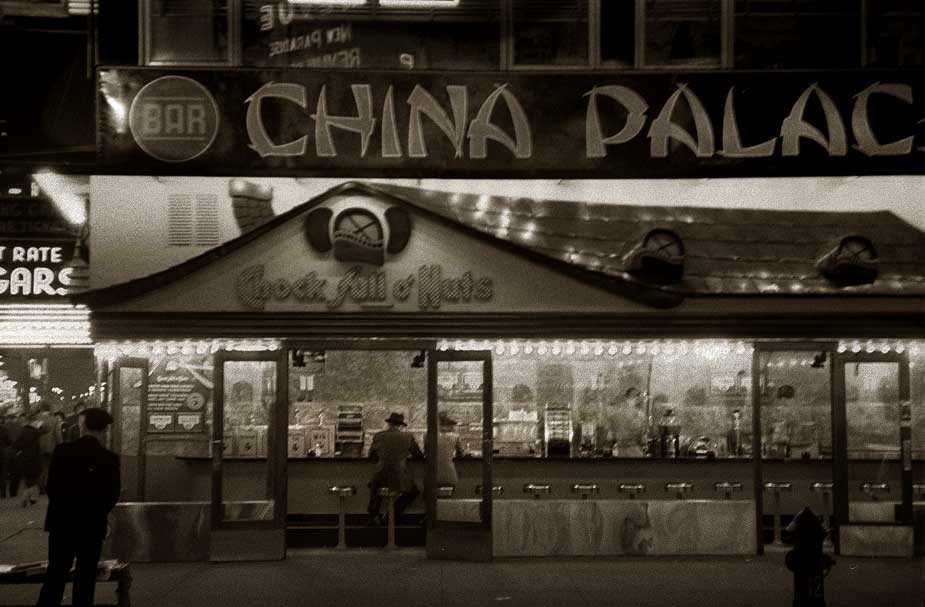 Detail: "Chock Full o' Nuts at Night": Laural J. Jones, American: 2004 digital scan taken from ca. 1938-1945 black and white film negative: This nighttime view believed to have been taken in Brooklyn Heights shows the popular post-Depression coffee shop with the large China Palace restaurant behind it. The coffee brand still marketed today featured shops selling a cup of coffee and sandwich for only a nickel. (at the time, there were 18 shops around New York) A police officer looks on at foreground left while a gentleman wearing his hat can be seen seated along a row of stools through the open doorway of the establishment at center. Courtesy: Private Florida Collection
Detail: "Chock Full o' Nuts at Night": Laural J. Jones, American: 2004 digital scan taken from ca. 1938-1945 black and white film negative: This nighttime view believed to have been taken in Brooklyn Heights shows the popular post-Depression coffee shop with the large China Palace restaurant behind it. The coffee brand still marketed today featured shops selling a cup of coffee and sandwich for only a nickel. (at the time, there were 18 shops around New York) A police officer looks on at foreground left while a gentleman wearing his hat can be seen seated along a row of stools through the open doorway of the establishment at center. Courtesy: Private Florida Collection
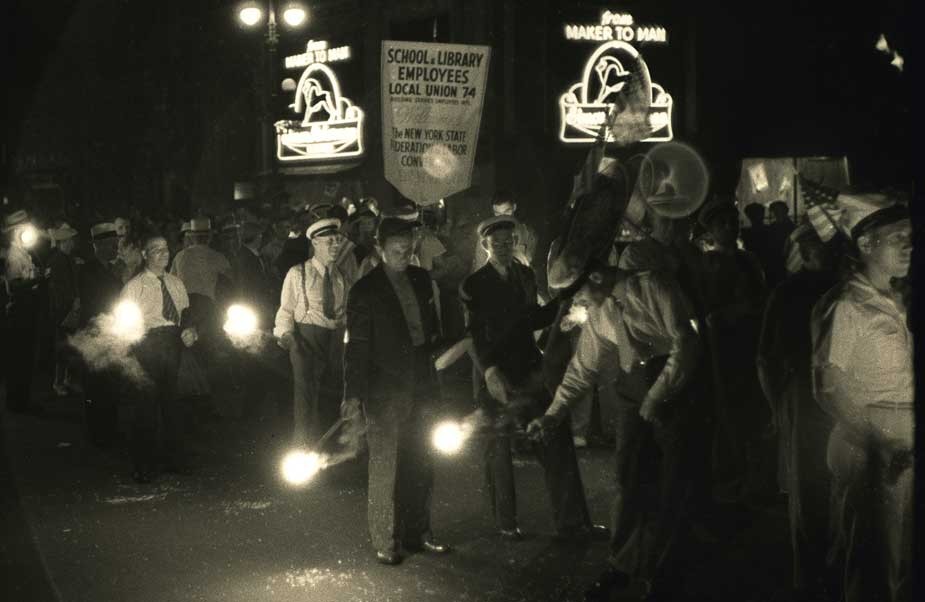 Detail: "Union Rally at Night": Laural J. Jones, American: 2004 digital scan taken from ca. 1938-1945 black and white film negative: Holding flares and American flags, a nighttime rally of custodians employed by New York City custodians, members of School & Library Employees Local Union 74, takes place at an unknown New York City location. Courtesy: Private Florida Collection
Detail: "Union Rally at Night": Laural J. Jones, American: 2004 digital scan taken from ca. 1938-1945 black and white film negative: Holding flares and American flags, a nighttime rally of custodians employed by New York City custodians, members of School & Library Employees Local Union 74, takes place at an unknown New York City location. Courtesy: Private Florida Collection
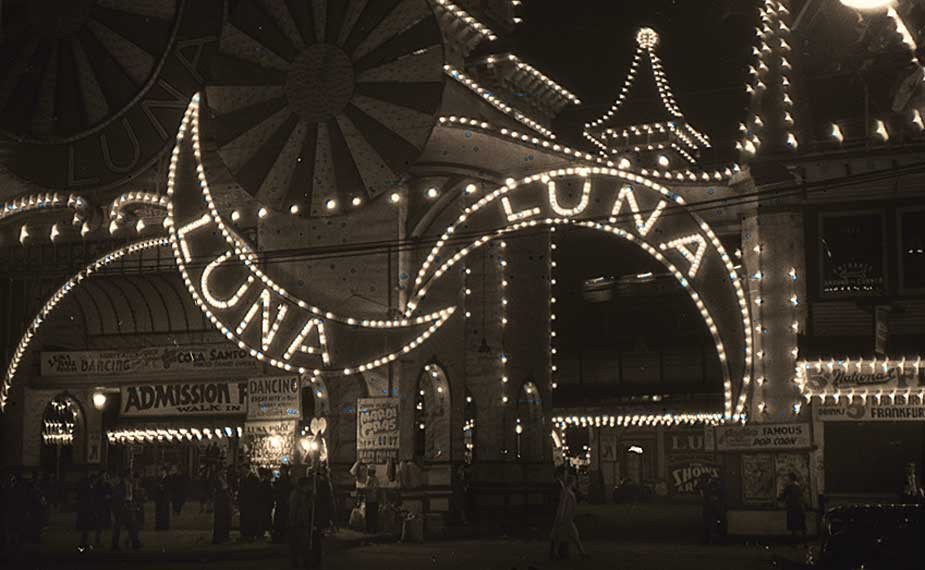 Detail: "Entrance to Luna Park, Coney Island at Night": Laural J. Jones, American: 2004 digital scan taken from ca. 1938-1945 black and white film negative: Luna Park was an amusement park in Coney Island, Brooklyn, in New York City that first opened in 1903 and was destroyed by fire in 1944. It finally closed in 1946 after a second fire. Courtesy: Private Florida Collection
Detail: "Entrance to Luna Park, Coney Island at Night": Laural J. Jones, American: 2004 digital scan taken from ca. 1938-1945 black and white film negative: Luna Park was an amusement park in Coney Island, Brooklyn, in New York City that first opened in 1903 and was destroyed by fire in 1944. It finally closed in 1946 after a second fire. Courtesy: Private Florida Collection
Taking advantage of city life, while using the Leica 35mm rangefinder to record night scenes a speciality, Laural Jones documented a fascinating and important record of Manhattan and the outer boroughs from the late 1930’s and into the 1940’s, with some of the larger events unfolding before his camera spanning the later years of the American Depression and leading through to the re-ordering of a new world order brought on by World War II. Sadly, the story of preservation as it relates to someones creative and personal artistic endeavors is one consistent with people’s indifference to memories and Photography’s evolving history. But survivors like Laural Jones do show up, thankfully, and in these nine digital offerings, I think you will find plenty to be fascinated with and hopefully inspired by.
David Spencer-
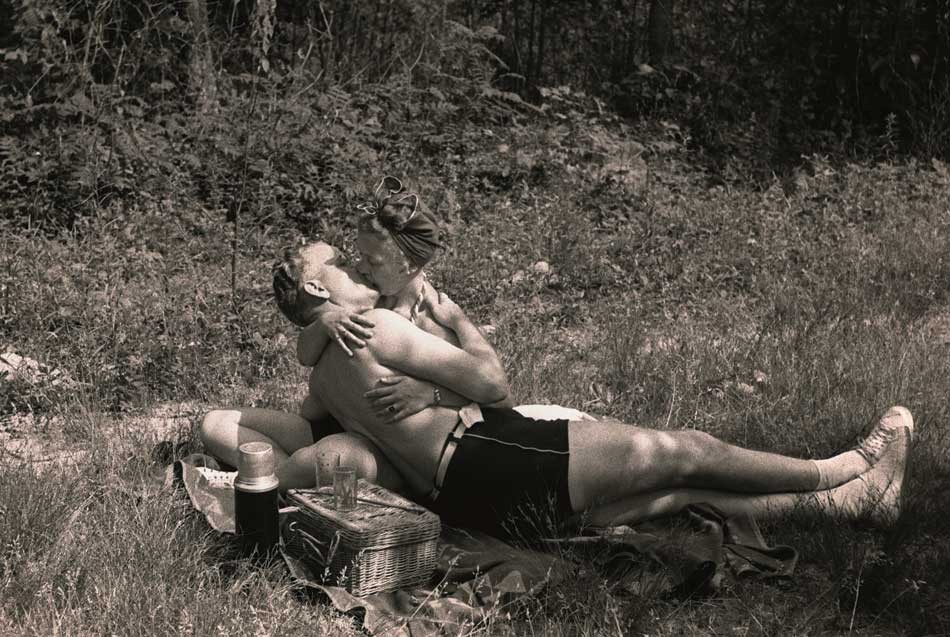 Detail: "Picnic Kiss": Laural J. Jones, American: 2004 digital scan taken from ca. 1938-1945 black and white film negative. Laying on a blanket shirtless, and with a picnic hamper and two glasses balancing on top at left, the photographer Laural Jones kisses a woman that may be his future spouse Edith at an unknown location. This woman appears in many surviving negatives taken by the photographer, including one of her on the Asbury Park boardwalk at the top of this post. Courtesy: Private Florida Collection
Detail: "Picnic Kiss": Laural J. Jones, American: 2004 digital scan taken from ca. 1938-1945 black and white film negative. Laying on a blanket shirtless, and with a picnic hamper and two glasses balancing on top at left, the photographer Laural Jones kisses a woman that may be his future spouse Edith at an unknown location. This woman appears in many surviving negatives taken by the photographer, including one of her on the Asbury Park boardwalk at the top of this post. Courtesy: Private Florida Collection
Support our Vision, Validate our Passion
Posted March 2017 in Advertising, Childhood Photography, Documentary Photography, PhotoSeed, PhotoSeed Gallery
Like what you see on PhotoSeed? Have you ever thought of collecting vintage photographs? It might seem strange for some in our modern age of digital connoisseurship, where family photo albums now reside, along with everything else, on your smartphones. But actual physical photographs, unlike their digital brothers and sisters, do actually stand the test of time. You can even hang them on your wall!
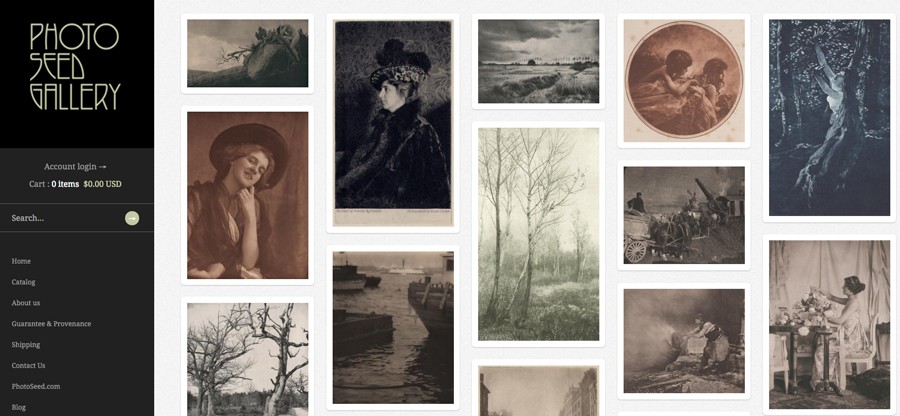 Screengrab of the homepage for the PhotoSeed Gallery website hosted by Shopify e-commerce online platform: March, 2017
Screengrab of the homepage for the PhotoSeed Gallery website hosted by Shopify e-commerce online platform: March, 2017
If you’ve arrived here by chance, or are a long-time visitor, you might have thought that some of these digital photographs are quite beautiful. Wouldn’t it be nice to…perhaps, acquire an original for yourself, a friend or loved one? Well today is your lucky day. After nearly two decades of collecting, I’m going in a new direction and launching PhotoSeed Gallery. The new venture is designed to give anyone in the world (we ship internationally) the opportunity to purchase vintage photographic works of art (never reproductions) created from roughly 1885-1920. Heck, you don’t even need to leave home to do it. A desktop computer will give you the best feel and display for the site, but if you insist, that aforementioned smartphone will also do the trick nicely from anywhere.
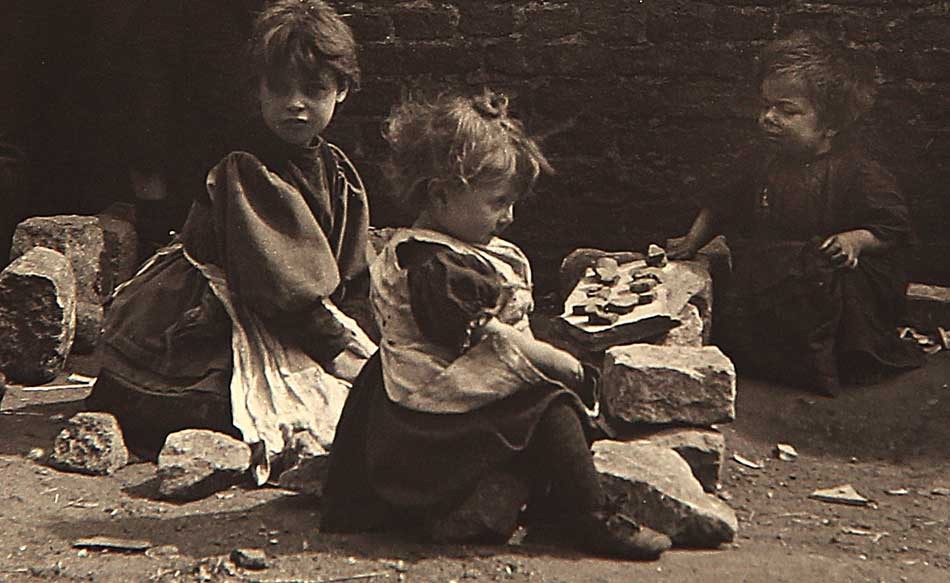 Detail: Playing at Shops: Edgar G. Lee, English: (1860-1915) vintage exhibition lantern slide ca. 1895-1905: 8.2 x 8.2 cm. A portrait photographer by trade, Englishman Edgar Lee was an active exhibitor in the Royal Photographic Society Salons from 1890-1903. The body of work he is best remembered for however is documentary, with 300 of his lantern slides held in the Woodhorn Museum and Northumberland Archives chronicling the residents, mostly poor, of the Quayside area of Newcastle upon Tyne. PhotoSeed owns several examples of Lee's work, including this street view showing a group of little girls- with two clad in white aprons at front and left- pretending to sell what appears to be an assortment of rocks or broken tiles arranged on a table made from slate and rocks. Interestingly, a postcard of this image: "Playing at Shops: The Slums, Sandgate" was later published by his Newcastle firm Thompson and Lee, the work possibly part of his earlier documentary involvement with investigations conducted by the Royal Commission on the Poor Laws and Relief of Distress in England held from 1905-09. From: PhotoSeed Archive
Detail: Playing at Shops: Edgar G. Lee, English: (1860-1915) vintage exhibition lantern slide ca. 1895-1905: 8.2 x 8.2 cm. A portrait photographer by trade, Englishman Edgar Lee was an active exhibitor in the Royal Photographic Society Salons from 1890-1903. The body of work he is best remembered for however is documentary, with 300 of his lantern slides held in the Woodhorn Museum and Northumberland Archives chronicling the residents, mostly poor, of the Quayside area of Newcastle upon Tyne. PhotoSeed owns several examples of Lee's work, including this street view showing a group of little girls- with two clad in white aprons at front and left- pretending to sell what appears to be an assortment of rocks or broken tiles arranged on a table made from slate and rocks. Interestingly, a postcard of this image: "Playing at Shops: The Slums, Sandgate" was later published by his Newcastle firm Thompson and Lee, the work possibly part of his earlier documentary involvement with investigations conducted by the Royal Commission on the Poor Laws and Relief of Distress in England held from 1905-09. From: PhotoSeed Archive
Many websites solicit funding via one of those “donate here” buttons for their upkeep and survival. I can appreciate that, but somehow, in my humble estimation, it is so much better to support your love of photography by receiving something in return: in this case, tangible and real photographs. Going forward, gallery sales will be vital and necessary for maintaining PhotoSeed’s core mission of bringing attention to the often obscure and forgotten practitioners from photography’s past, as well as the critical and time-consuming scholarship their work demands in giving it the proper due it deserves for the larger historical record. And no worries, I’m a collector myself at heart, so our intent will always be the continual addition of rare and surprising examples to this record in the coming years.
Thanks for stopping by, and please consider a purchase to support our vision and validate our passion.
-David Spencer PhotoSeed Archive & Gallery owner and curator March, 2017
Old Nasty Women
Posted January 2017 in Documentary Photography, History of Photography, New Additions, Significant Photographers, Significant Photographs
The historical photographic record doesn’t flinch when it comes to the importance of women, and I present herewith a short gallery as evidence, many of these photographs taken by women themselves. Mother Earth was surely proud of those millions who turned out in rallies all over the United States and across the World in support of the fairer sex on Saturday. And in Washington, D.C., it was a pointed, diverse, and joyous message presenting the true story of America heard loud and clear countering the utterances of the keynote speaker the day before.
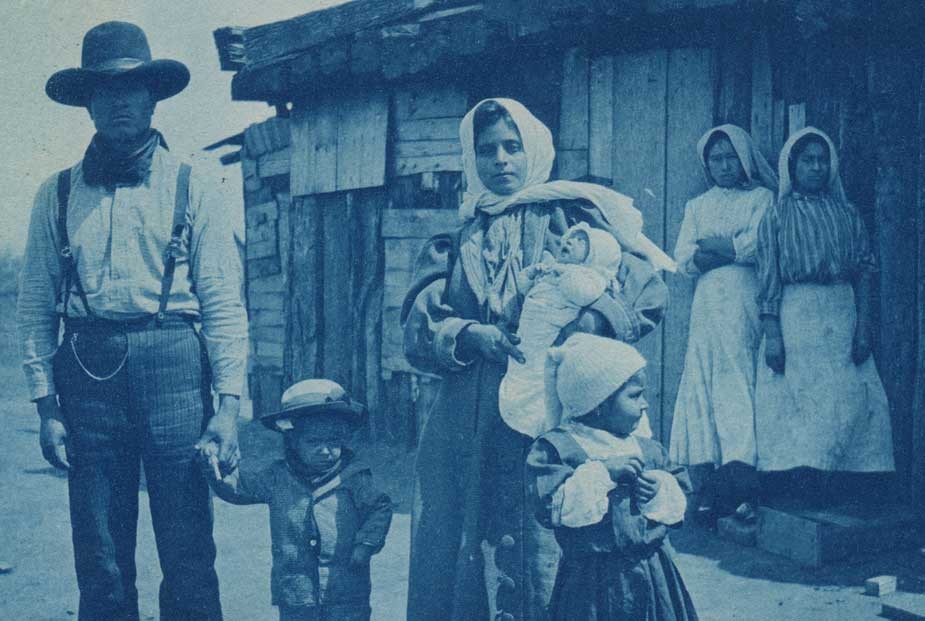 A Message to Washington: "Sweet-faced Little Mother" : Detail: Anonymous American Photographer: 1911: Cyanotype postcard mailed to Washington D.C. from Sweetwater Texas showing a proud Mexican family in front of their Texas & Pacific Railroad section house. 7.4 x 9.9 cm | 8.7 x 13.9 cm: Besides being built with the hard labor of Mexican and other nationalities in the later 19th Century, continued maintenance of American railroads like the "T & P" in places like Texas in the early 20th was often performed by them, with the rail line providing section houses along the track for temporary quarters to live in. Writing to a Mrs. Burnside on the card's verso, the following appears in neat script: "This man came up and asked me to come and take a picture of his baby, "just borned"-When I got there, the whole family wanted to be taken-so here they are the sweet-faced little mother and the baby, not quite 2 weeks old. They are such a happy-hearted class of people." From: PhotoSeed Archive
A Message to Washington: "Sweet-faced Little Mother" : Detail: Anonymous American Photographer: 1911: Cyanotype postcard mailed to Washington D.C. from Sweetwater Texas showing a proud Mexican family in front of their Texas & Pacific Railroad section house. 7.4 x 9.9 cm | 8.7 x 13.9 cm: Besides being built with the hard labor of Mexican and other nationalities in the later 19th Century, continued maintenance of American railroads like the "T & P" in places like Texas in the early 20th was often performed by them, with the rail line providing section houses along the track for temporary quarters to live in. Writing to a Mrs. Burnside on the card's verso, the following appears in neat script: "This man came up and asked me to come and take a picture of his baby, "just borned"-When I got there, the whole family wanted to be taken-so here they are the sweet-faced little mother and the baby, not quite 2 weeks old. They are such a happy-hearted class of people." From: PhotoSeed Archive
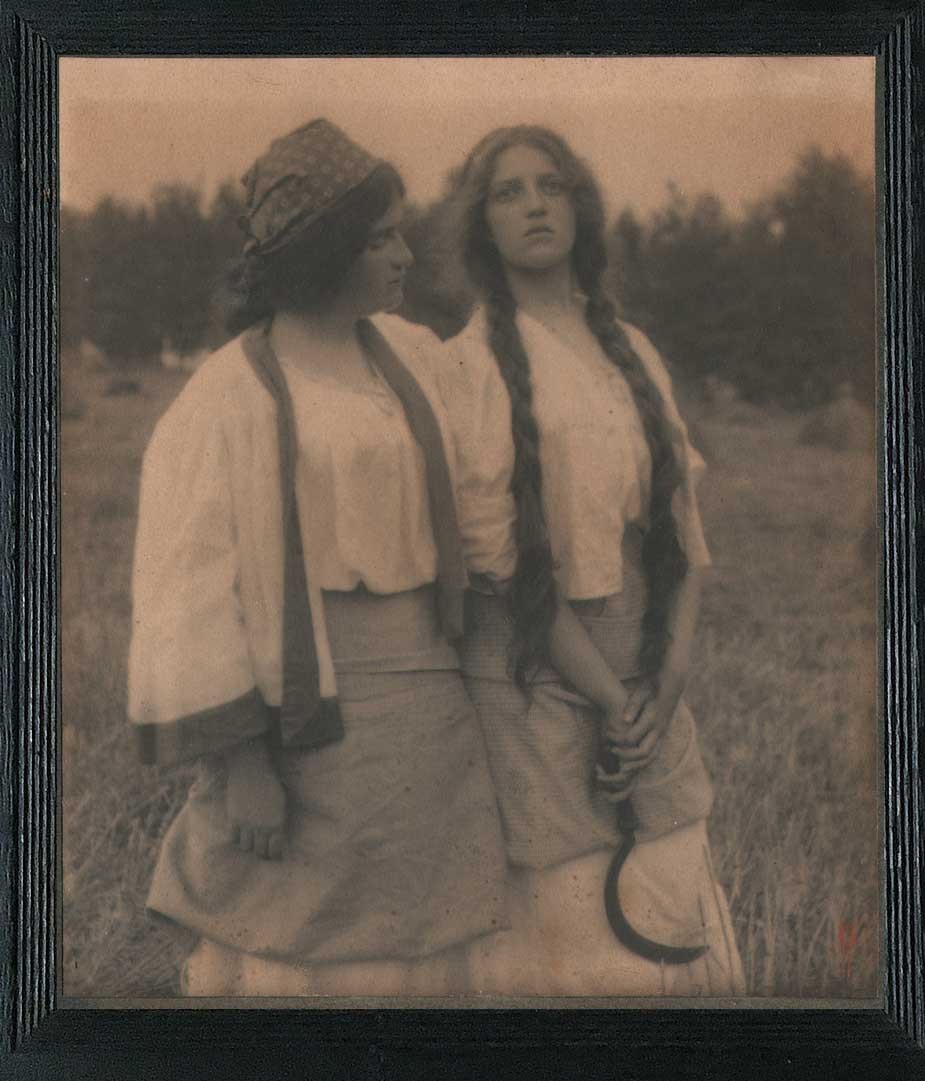 "The Song of the Meadow Lark": Mathilde Weil: American: (1872-1942) ca. 1900: Platinum print mounted on board signed in red with Weil cipher at lower right: 18.4 x 16.0 cm | 19.1 x 16.5 cm: black-painted wood frame: 28.4 x 25.7 cm: In December, 1899, critic Francis J. Ziegler, writing in Brush and Pencil for a review of the Philadelphia Photographic Salon, said of this photograph: "Among Philadelphia's artist photographers one of the most prominent is Miss Mathilde Weil, and her contributions to this exhibition are full of artistic excellence. Her "Song of the Meadow-Lark" has a suggestion of the Orient about it, notwithstanding the fact that the landscape is an American field and the two girls who have stopped in their reaping have American faces. This effect, I think, is due to the long braids of hair which hang down the front of one damsel's bodice, and the white jacket worn by her companion, the trimming of which repeats the same lines in artistic harmony." (p. 113) From: PhotoSeed Archive
"The Song of the Meadow Lark": Mathilde Weil: American: (1872-1942) ca. 1900: Platinum print mounted on board signed in red with Weil cipher at lower right: 18.4 x 16.0 cm | 19.1 x 16.5 cm: black-painted wood frame: 28.4 x 25.7 cm: In December, 1899, critic Francis J. Ziegler, writing in Brush and Pencil for a review of the Philadelphia Photographic Salon, said of this photograph: "Among Philadelphia's artist photographers one of the most prominent is Miss Mathilde Weil, and her contributions to this exhibition are full of artistic excellence. Her "Song of the Meadow-Lark" has a suggestion of the Orient about it, notwithstanding the fact that the landscape is an American field and the two girls who have stopped in their reaping have American faces. This effect, I think, is due to the long braids of hair which hang down the front of one damsel's bodice, and the white jacket worn by her companion, the trimming of which repeats the same lines in artistic harmony." (p. 113) From: PhotoSeed Archive
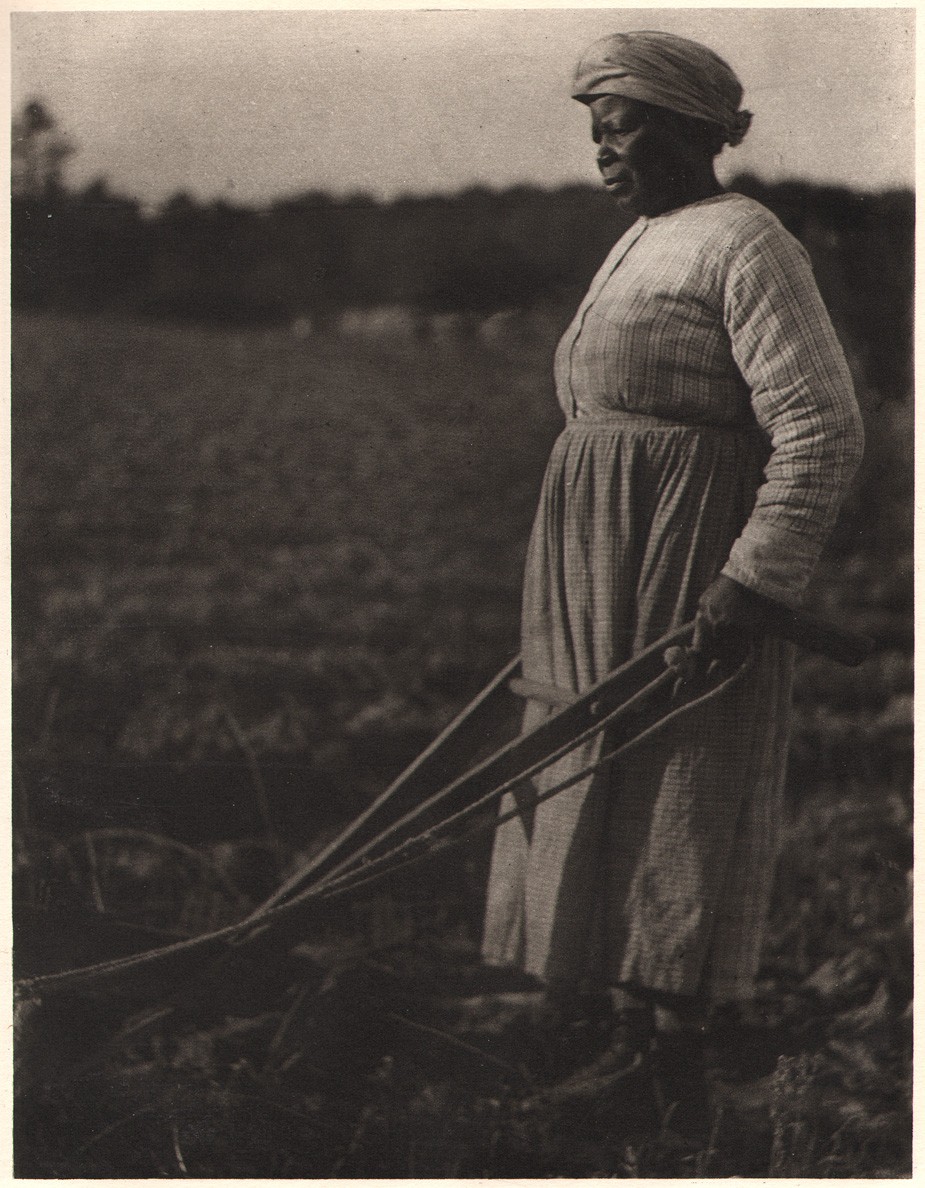 "Woman Behind Plow": Doris Ulmann, American: (1882-1934): 1933: hand-pulled photogravure: Plate 39 from the deluxe volume Roll Jordan Roll: New York: Robert O. Ballou: (text by Julia Peterkin) 21.2 x 16.3 | 28.4 x 20.5 cm: A landmark photographic volume of the 20th Century featuring ethnographic studies and portraits, this volume features 90 full-page copperplate gravures done in the Pictorial manner. Writing for the Amon Carter Museum of American Art in Texas, author Steve Watson describes the volume in part: "The book focuses on the lives of former slaves and their descendants on a plantation in the Gullah coastal region of South Carolina. Peterkin, who won the Pulitzer Prize for her novel Scarlet Sister Mary (Indianapolis: Bobbs-Merrill, 1928), was born in South Carolina and raised by a black nursemaid who taught her the Gullah dialect. She married the heir to Lang Syne, a 2,000-acre cotton plantation, which became the setting for Roll, Jordan, Roll. Ulmann began photographing there in 1929." From: PhotoSeed Archive
"Woman Behind Plow": Doris Ulmann, American: (1882-1934): 1933: hand-pulled photogravure: Plate 39 from the deluxe volume Roll Jordan Roll: New York: Robert O. Ballou: (text by Julia Peterkin) 21.2 x 16.3 | 28.4 x 20.5 cm: A landmark photographic volume of the 20th Century featuring ethnographic studies and portraits, this volume features 90 full-page copperplate gravures done in the Pictorial manner. Writing for the Amon Carter Museum of American Art in Texas, author Steve Watson describes the volume in part: "The book focuses on the lives of former slaves and their descendants on a plantation in the Gullah coastal region of South Carolina. Peterkin, who won the Pulitzer Prize for her novel Scarlet Sister Mary (Indianapolis: Bobbs-Merrill, 1928), was born in South Carolina and raised by a black nursemaid who taught her the Gullah dialect. She married the heir to Lang Syne, a 2,000-acre cotton plantation, which became the setting for Roll, Jordan, Roll. Ulmann began photographing there in 1929." From: PhotoSeed Archive
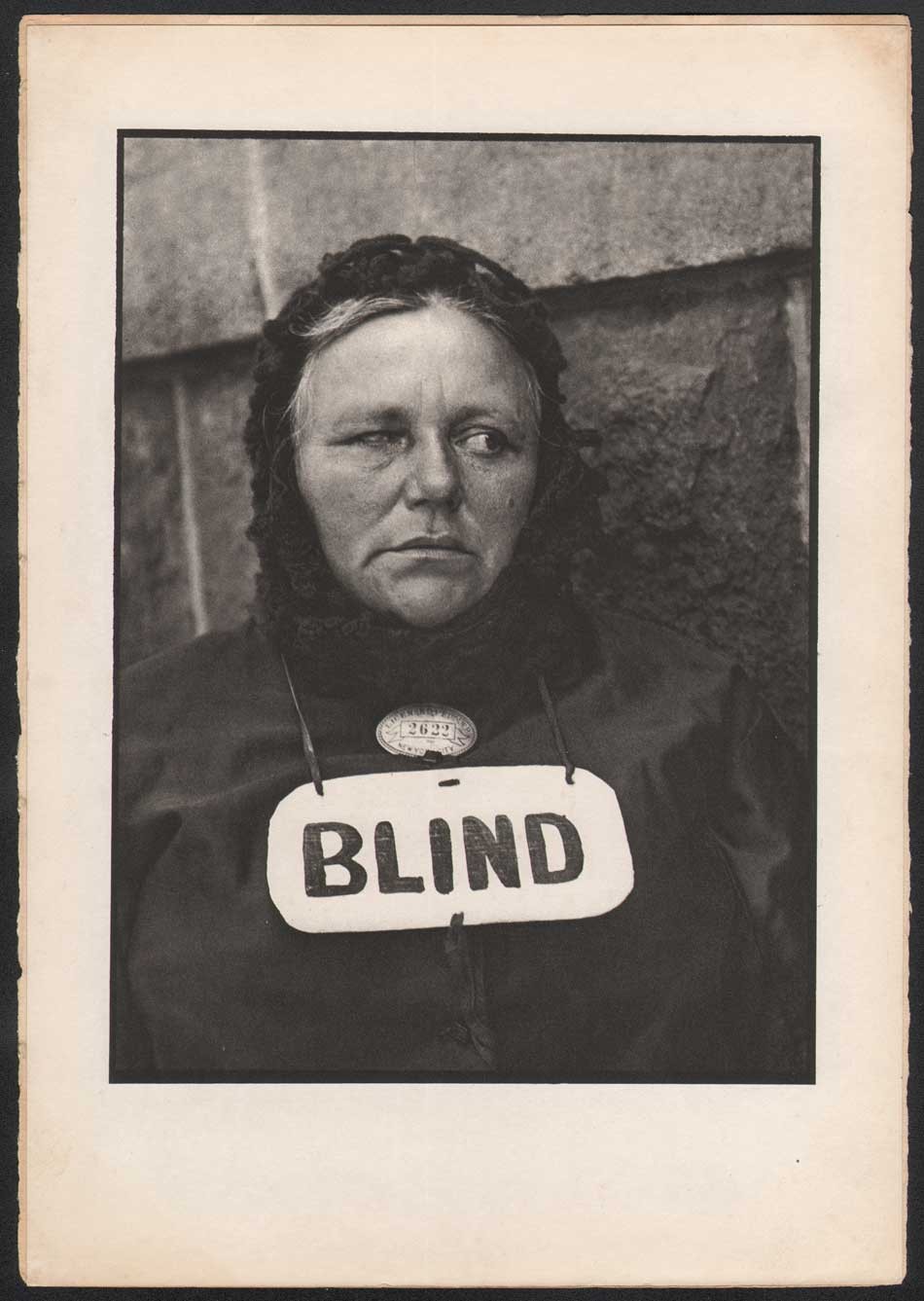 "Photograph-New York": Paul Strand, American: (1890-1976): 1917: hand-pulled photogravure from Camera Work XLIX/L: 22.4 x 16.6 | 29.7 x 20.6 cm: This iconic portrait of a blind woman, who has been issued a peddler's license by the city seen above her sign, was taken by Strand with the aid of either a false or prism lens as part of a series of ground-breaking modernist photographs done on the streets of New York City in the Fall of 1916. Writing the same year this portrait appeared in Camera Work, in August, 1917, an essay on Photography for the journal The Seven Arts concludes with the following observations by Strand-observations that could also certainly apply to the joyful diversity of human beings themselves, as in this case- womankind herself: "The existence of a medium, after all, is its absolute justification, if as so many seem to think, it needs one, and all comparison of potentialities is useless and irrelevant. Whether a water-color is inferior to an oil, or whether a drawing, an etching, or a photograph is not as important as either, is inconsequent. To have to despise something else is a sign of impotence. Let us rather accept joyously and with gratitude everything through which the spirit of man seeks to an ever fuller and more intense self-realization." (pp. 525-26) From: PhotoSeed Archive
"Photograph-New York": Paul Strand, American: (1890-1976): 1917: hand-pulled photogravure from Camera Work XLIX/L: 22.4 x 16.6 | 29.7 x 20.6 cm: This iconic portrait of a blind woman, who has been issued a peddler's license by the city seen above her sign, was taken by Strand with the aid of either a false or prism lens as part of a series of ground-breaking modernist photographs done on the streets of New York City in the Fall of 1916. Writing the same year this portrait appeared in Camera Work, in August, 1917, an essay on Photography for the journal The Seven Arts concludes with the following observations by Strand-observations that could also certainly apply to the joyful diversity of human beings themselves, as in this case- womankind herself: "The existence of a medium, after all, is its absolute justification, if as so many seem to think, it needs one, and all comparison of potentialities is useless and irrelevant. Whether a water-color is inferior to an oil, or whether a drawing, an etching, or a photograph is not as important as either, is inconsequent. To have to despise something else is a sign of impotence. Let us rather accept joyously and with gratitude everything through which the spirit of man seeks to an ever fuller and more intense self-realization." (pp. 525-26) From: PhotoSeed Archive
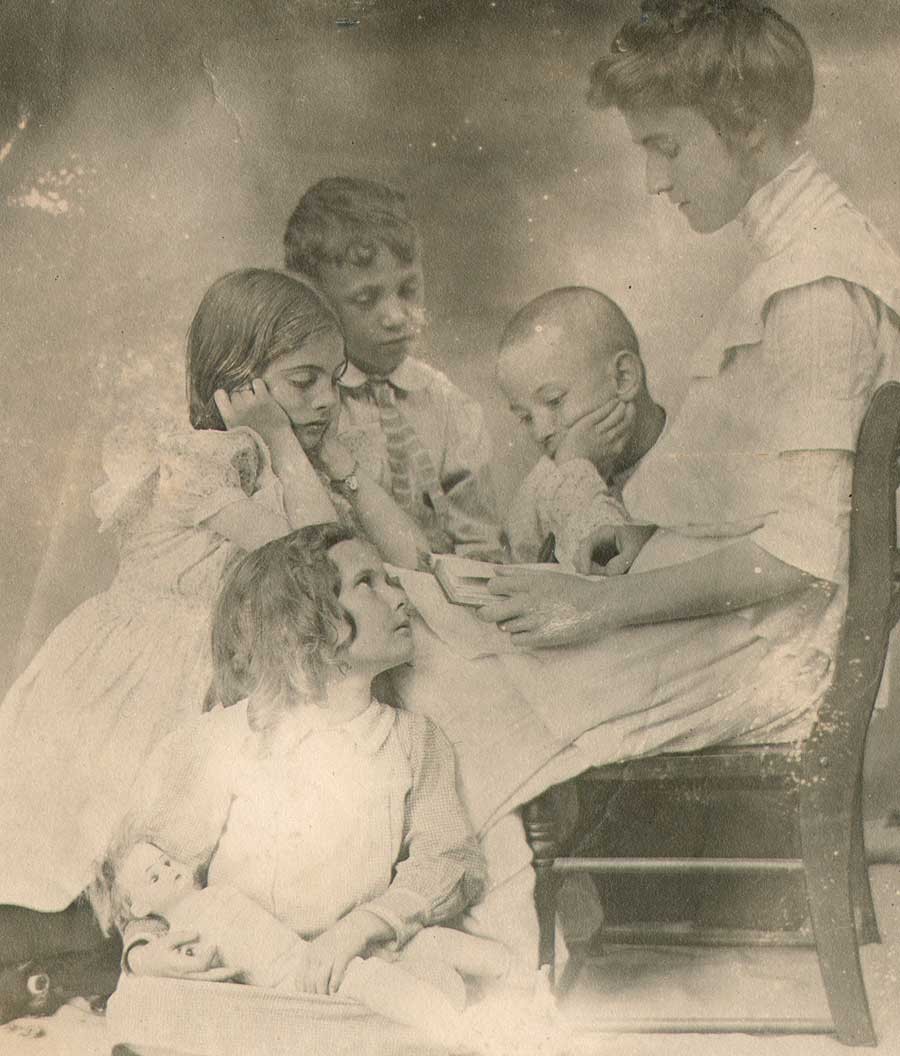 Detail: "Untitled Study of Woman Reading to Children: Juliana Royster, American: ( 1876-1962) ca. 1905-10: Gelatino-Choloride (POP) print: 11.8 x 10.0 cm: An artist who excelled in multiple mediums, Juliana Royster, from Raleigh, North Carolina, learned photography while attending Saint Mary’s School there, and is best known in the modern era for her founding in 1917, along with husband Jacques (born James) Busbee, (1870-1947) the Jugtown Pottery in Seagrove, North Carolina. From: PhotoSeed Archive
Detail: "Untitled Study of Woman Reading to Children: Juliana Royster, American: ( 1876-1962) ca. 1905-10: Gelatino-Choloride (POP) print: 11.8 x 10.0 cm: An artist who excelled in multiple mediums, Juliana Royster, from Raleigh, North Carolina, learned photography while attending Saint Mary’s School there, and is best known in the modern era for her founding in 1917, along with husband Jacques (born James) Busbee, (1870-1947) the Jugtown Pottery in Seagrove, North Carolina. From: PhotoSeed Archive
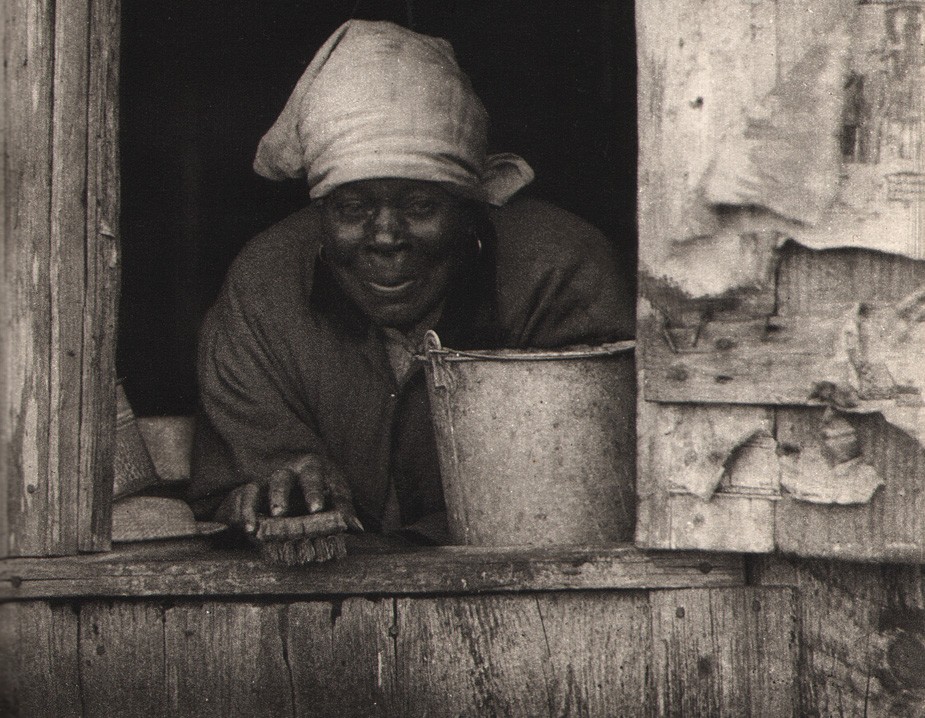 Detail: "Woman with Scrub brush Looking out Window": Doris Ulmann, American: (1882-1934): 1933: hand-pulled photogravure: Plate 66 from the deluxe volume Roll Jordan Roll: New York: Robert O. Ballou: (text by Julia Peterkin) 21.0 x 16.3 | 28.4 x 20.5 cm: A landmark photographic volume of the 20th Century featuring ethnographic studies and portraits, this volume features 90 full-page copperplate gravures done in the Pictorial manner. Writing for the Amon Carter Museum of American Art in Texas, author Steve Watson describes the volume in part: "The book focuses on the lives of former slaves and their descendants on a plantation in the Gullah coastal region of South Carolina. Peterkin, who won the Pulitzer Prize for her novel Scarlet Sister Mary (Indianapolis: Bobbs-Merrill, 1928), was born in South Carolina and raised by a black nursemaid who taught her the Gullah dialect. She married the heir to Lang Syne, a 2,000-acre cotton plantation, which became the setting for Roll, Jordan, Roll. Ulmann began photographing there in 1929." From: PhotoSeed Archive
Detail: "Woman with Scrub brush Looking out Window": Doris Ulmann, American: (1882-1934): 1933: hand-pulled photogravure: Plate 66 from the deluxe volume Roll Jordan Roll: New York: Robert O. Ballou: (text by Julia Peterkin) 21.0 x 16.3 | 28.4 x 20.5 cm: A landmark photographic volume of the 20th Century featuring ethnographic studies and portraits, this volume features 90 full-page copperplate gravures done in the Pictorial manner. Writing for the Amon Carter Museum of American Art in Texas, author Steve Watson describes the volume in part: "The book focuses on the lives of former slaves and their descendants on a plantation in the Gullah coastal region of South Carolina. Peterkin, who won the Pulitzer Prize for her novel Scarlet Sister Mary (Indianapolis: Bobbs-Merrill, 1928), was born in South Carolina and raised by a black nursemaid who taught her the Gullah dialect. She married the heir to Lang Syne, a 2,000-acre cotton plantation, which became the setting for Roll, Jordan, Roll. Ulmann began photographing there in 1929." From: PhotoSeed Archive
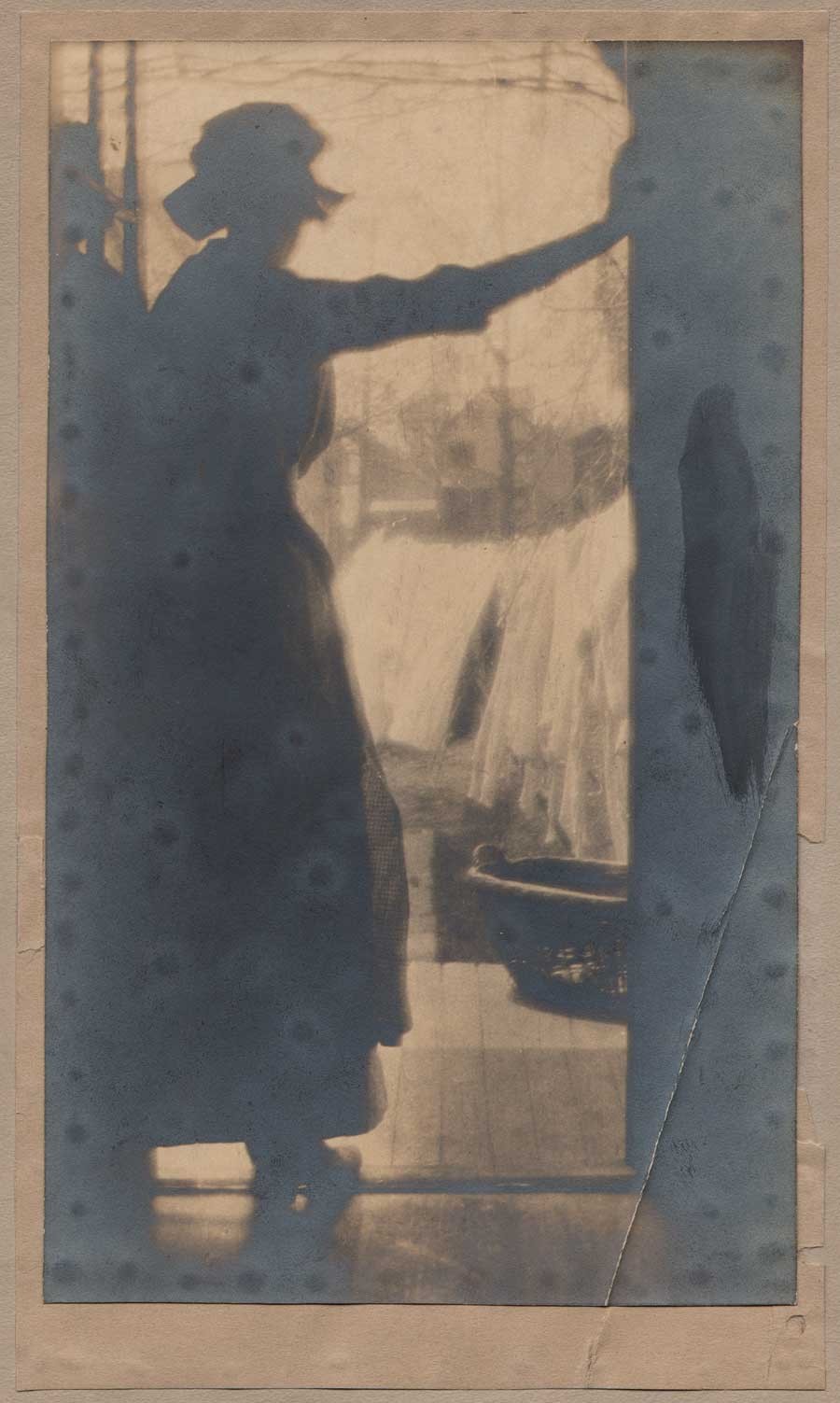 "A Moments Leisure": Ben J. Boyd: American, ( 1881-1958): ca. 1915-20: Gelatin Silver print, mounted: 24.0 x 14.4 | 26.3 x 15.4 | 34.2 x 26.6 cm: Silhouetted in a doorway, a woman takes a break from hanging laundry seen at center in this unusual home-life study depicting the everyday struggle of women done here by long-time Wilkes-Barre, PA resident and Camera Club member Benjamin Joslin Boyd. From: PhotoSeed Archive
"A Moments Leisure": Ben J. Boyd: American, ( 1881-1958): ca. 1915-20: Gelatin Silver print, mounted: 24.0 x 14.4 | 26.3 x 15.4 | 34.2 x 26.6 cm: Silhouetted in a doorway, a woman takes a break from hanging laundry seen at center in this unusual home-life study depicting the everyday struggle of women done here by long-time Wilkes-Barre, PA resident and Camera Club member Benjamin Joslin Boyd. From: PhotoSeed Archive
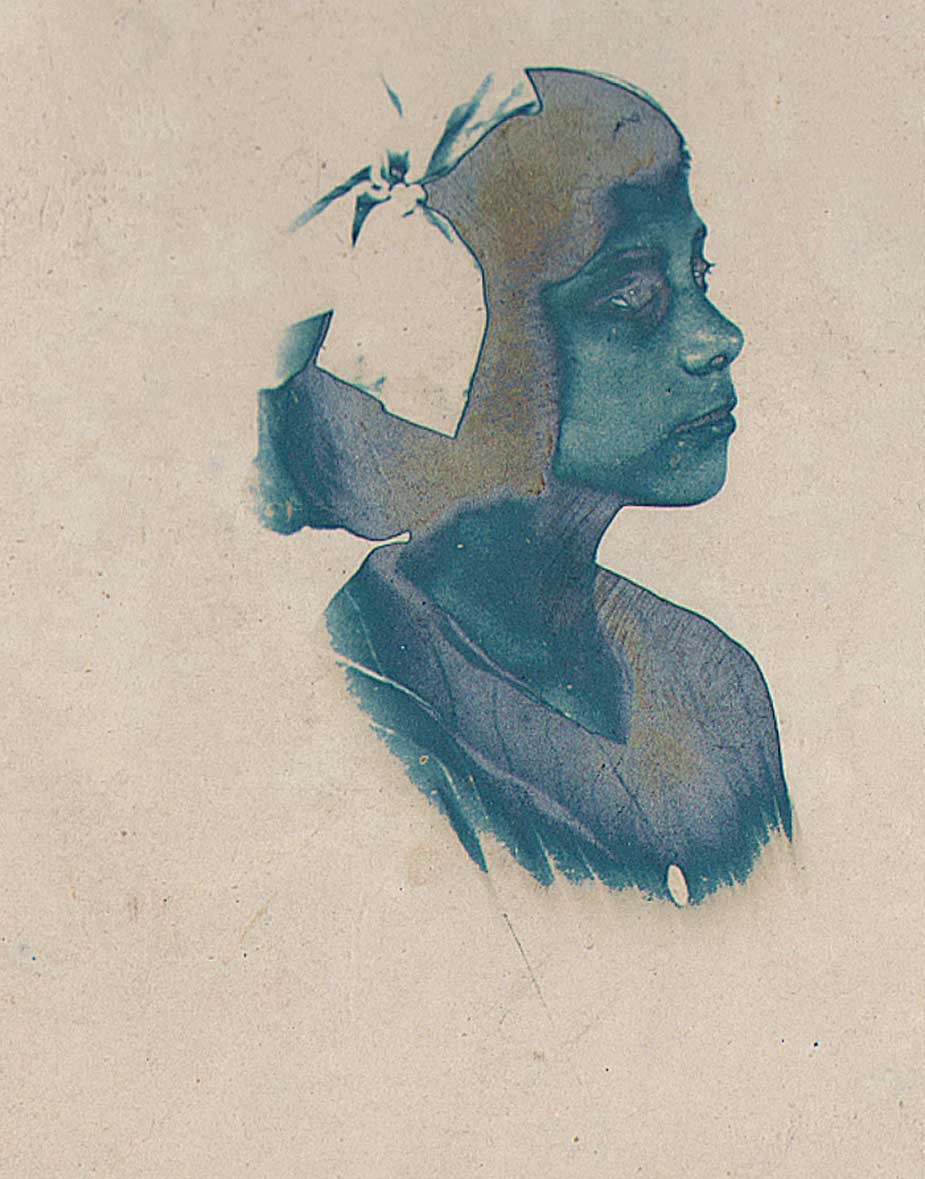 "Female Head Study": unknown, probably American photographer: ca. 1900-20: Reverse negative, Gelatin-silver over Cyanotype photograph, unmounted: 8.7 x 6.2 cm: Whether intentional or not, and for the purposes of this post, this alternative, multi-process study of a young woman is symbolic for a joyous, multi-ethnic celebration of women's diversity everywhere. From: PhotoSeed Archive
"Female Head Study": unknown, probably American photographer: ca. 1900-20: Reverse negative, Gelatin-silver over Cyanotype photograph, unmounted: 8.7 x 6.2 cm: Whether intentional or not, and for the purposes of this post, this alternative, multi-process study of a young woman is symbolic for a joyous, multi-ethnic celebration of women's diversity everywhere. From: PhotoSeed Archive